2021 Annual Report for: Noctuidae / Hadeninae
For species seen in 2021 that had less than or equal to 100 records, full details are included; for more common species, the earliest, latest and highest count by vice-county are shown. The narrative for each species is taken from the main Hantsmoths website, and it is possible that some information on abundance and occurrence can get out of date, as it is impossible to keep up with all changes; however it should give a good introduction to each species. The tables in each species account summarise the previous status, and that for the current year.
For the maps, all records prior to 2021 are shown by a blue dot (the larger the dot, the more recent), with the current year's records shown in red. As previous records are superimposed on any report for 2021, new sites have greater emphasis (i.e. will show as 'more red').
In the species accounts, an asterisk next to a location indicates a new 10km square record; earliest ever dates are highlighted in orange, and latest ever in red. Initials in the species accounts refer to the recorders listed here. Please get in touch if you identify any omissions or errors, in particular if you have records that have yet to be submitted. Details of how to submit records can be found here.
73.241 [B&F: 2179] Pine Beauty Panolis flammea ([Denis & Schiffermüller], 1775) - Common
Common in coniferous and mixed woodland, plantations, parks and gardens throughout the British Isles. Widespread and fairly common in Hampshire and on the Isle of Wight. Wingspan 32-40 mm. Unmistakable. Larva feeds on needles of Scots, Corsican, Lodgepole and Maritime Pine.
Records prior to 2021
| Vice County | #Records | #Individuals | First Record | Last Record |
|---|---|---|---|---|
| 10 | 81 | 63 | 1856 | 2020 |
| 11 | 1311 | 1596 | 1950 | 2020 |
| 12 | 347 | 411 | 1951 | 2020 |
2021 records
| Vice County | #Records | #Individuals | Max Quantity |
|---|---|---|---|
| 10 | 2 | 2 | 1 |
| 11 | 18 | 20 | 3 |
| 12 | 16 | 26 | 3 |
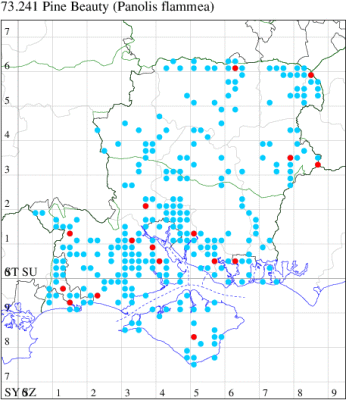
Records by year
Records by week (adult)
Records by week (larval)
Record Details
VC10: Rookley, one, 15 Mar; one, 20 Apr (JRB);
VC11: Fordingbridge, one, 11 Jun (SCT); Marchwood, one, 18 Mar (CTha); Ashurst, NF, one, 24 Apr; one, 01 Jun (SAB); Romsey, one, 15 Mar (MBak); Dibden Purlieu, one, 01 Jun; one, 02 Jun; one, 01 Jun (RAC); Fareham, one, 24 Mar (ADT); Botley, one, 31 Mar; one, 24 Mar (SLB); Portchester, one, 19 Mar; one, 04 Apr (JGS); Hurn, one, 11 Mar; three, 31 Mar; one, 09 Jun (MJef); Tuckton, Christchurch, one, 23 Mar (APar); New Milton, one, 31 Mar (RPH);
VC12: Pamber Forest, one, 31 Mar (GJD); Whitehill, two, 20 Mar; one, 27 Mar; one, 30 Mar; one, 31 Mar; two, 04 Apr; three, 20 Apr; two, 08 May; three, 09 May; one, 12 May; two, 14 May; one, 28 May; two, 10 Jun; one, 16 Jun (ASto); Hammer Vale, one, 01 Apr (ASwa); Blackwater, two, 31 Mar (BDal)
73.242 [B&F: 2188] Clouded Drab Orthosia incerta (Hufnagel, 1766) - Common
Common in woodland, gardens and wherever there are oak trees throughout the British Isles. Widespread and common in Hampshire and on the Isle of Wight. Wingspan 32-42 mm. Very variable and often a pitfall for beginners, but usually shows a series of three small blotches on forewing, lying just inside the subterminal fascia, one on the costa, one on the dorsum and one in between; a common species which, with experience, is easily recognisable by the diagnostic wing shape. Larva feeds on Sessile and Pedunculate Oak and various species of Willow, as well as a wide variety of deciduous trees and shrubs, including Silver and Downy Birch, Hawthorn, Hazel, Elm and Lime, over-wintering as a pupa.
Records prior to 2021
| Vice County | #Records | #Individuals | First Record | Last Record |
|---|---|---|---|---|
| 10 | 454 | 1015 | 1951 | 2020 |
| 11 | 6137 | 17706 | 1951 | 2020 |
| 12 | 2424 | 7600 | 1951 | 2020 |
2021 records
| Vice County | #Records | #Individuals | Max Quantity |
|---|---|---|---|
| 10 | 25 | 33 | 4 |
| 11 | 158 | 247 | 20 |
| 12 | 71 | 106 | 4 |
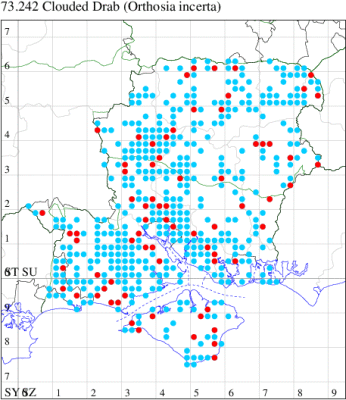
Records by year
Records by week (adult)
Records by week (larval)
Record Summary
VC10: Earliest: Shanklin, 15 Mar, 1 (IOut) Latest: Newport, 09 May, 1 (SuHug) Max count: Freshwater Bay, 14 Apr, 4 (SDav)
VC11: Earliest: Hurn, 19 Feb, 1 (MJef) Latest: Stanbrige Earls, 15 May, 1 (JRM) Max count: Hurn, 31 Mar, 20 (MJef)
VC12: Earliest: Blackwater, 16 Feb, 1 (BDal) Latest: Whitehill, 19 May, 1 (ASto) Max count: Barton Stacey, 31 Mar, 4 (GCE)
73.243 [B&F: 2183] Blossom Underwing Orthosia miniosa ([Denis & Schiffermüller], 1775) - Local
Local in oak woodland and mature hedgerows throughout much of southern England and Wales, north to Cumbria, also appearing as a migrant in the south. In Hampshire and on the Isle of Wight reported from scattered localities, and can be locally fairly common, for example in the New Forest, with some records relating to immigration. Wingspan 32-38 mm. The main confusion species, Common Quaker O. cerasi, has subterminal line complete and pale; upper stigmata clearly outlined whitish; median fascia, when present, narrow and dark; hindwing fuscous (MBGBI Vol 9). Larva feeds on Sessile Oak and Pedunculate Oak; also polyphagous on various herbaceous plants, over-wintering as a pupa.
Records prior to 2021
| Vice County | #Records | #Individuals | First Record | Last Record |
|---|---|---|---|---|
| 10 | 60 | 76 | 1800 | 2020 |
| 11 | 438 | 488 | 1940 | 2019 |
| 12 | 90 | 83 | 1940 | 2019 |
2021 records
| Vice County | #Records | #Individuals | Max Quantity |
|---|---|---|---|
| 10 | 3 | 3 | 1 |
| 11 | 2 | 6 | 3 |
| 12 | 3 | 3 | 1 |
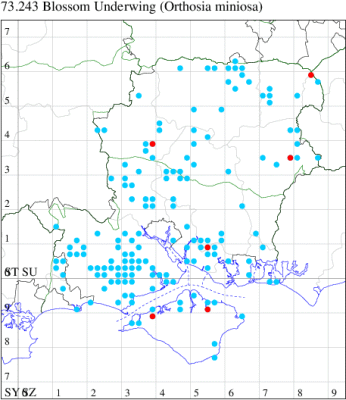
Records by year
Records by week (adult)
Records by week (larval)
Record Details
VC10: Cranmore, one, 22 Mar (CHic); Wootton Bridge, one, 03 Apr; one, 23 Apr (DElm);
VC11: Botley Wood, three, 09 Apr; three, 09 Apr (RJD, MLO, ADT, DWal, KJW);
VC12: Chilbolton, one, 08 Apr (GCE); Whitehill, one, 31 Mar (ASto); Blackwater, one, 24 Apr (BDal)
73.244 [B&F: 2187] Common Quaker Orthosia cerasi (Fabricius, 1775) - Common
Common often abundant, in a wide range of low-land habitats, including woodland and gardens throughout the British Isles. Widespread and common in Hampshire and on the Isle of Wight. Wingspan 34-40 mm. A very common early spring visitor to light traps, distinguished from the equally common Small Quaker O. cruda by the relatively large size and large orbicular stigma; and from Blossom Underwing O. miniosa by its complete and pale, upper stigmata clearly outlined whitish, median fascia, when present, narrow and dark, and hindwing fuscous (MBGBI Vol 9). Larva feeds on various herbaceous trees and shrubs, including Oak, Sallow, Birch, Elm, Hawthorn and Hazel, over-wintering as a pupa.
Records prior to 2021
| Vice County | #Records | #Individuals | First Record | Last Record |
|---|---|---|---|---|
| 10 | 1274 | 7786 | 1951 | 2020 |
| 11 | 11845 | 86702 | 1951 | 2020 |
| 12 | 3715 | 31905 | 1951 | 2020 |
2021 records
| Vice County | #Records | #Individuals | Max Quantity |
|---|---|---|---|
| 10 | 115 | 498 | 24 |
| 11 | 385 | 1095 | 25 |
| 12 | 182 | 654 | 30 |
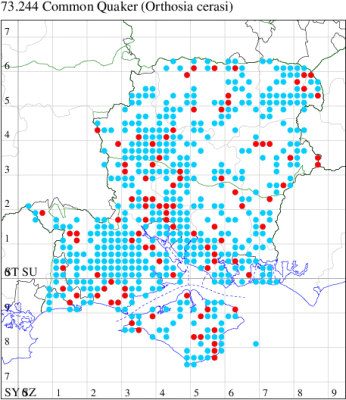
Records by year
Records by week (adult)
Records by week (larval)
Record Summary
VC10: Earliest: Bonchurch, 21 Feb, 1 (JHa) Latest: Bonchurch, 28 Jun, 1 (JHa) Max count: Bonchurch, 08 May, 24 (JHa)
VC11: Earliest: Fareham, 19 Feb, 1 (KJW) Latest: Botley, 31 Dec, 1 (SLB) Max count: Frogham, NF, 17 Mar, 25 (DBrd)
VC12: Earliest: Alton, 20 Feb, 1 (DBO) Latest: Minley Wood, 23 Jun, 1 (BDal) Max count: Grayshott, 31 Mar, 30 (THard)
73.245 [B&F: 2182] Small Quaker Orthosia cruda ([Denis & Schiffermüller], 1775) - Common
Common in broad-leaved woodland, areas with scattered trees and heathland throughout the British Isles. Widespread and extremely common in Hampshire and on the Isle of Wight, especially during warm dry springs. Wingspan 28-32 mm. A very common early spring visitor to light traps, where the small size and relatively small orbicular stigma easily distinguishes O. cruda from the equally common Common Quaker O. cerasi, and less frequent Blossom Underwing O. miniosa. Larva feeds on Pedunculate and Sessile Oak, Downy Birch, Hazel, Sallow and Field Maple.
Records prior to 2021
| Vice County | #Records | #Individuals | First Record | Last Record |
|---|---|---|---|---|
| 10 | 462 | 3381 | 1951 | 2020 |
| 11 | 5802 | 68199 | 1949 | 2020 |
| 12 | 2277 | 35179 | 1951 | 2020 |
2021 records
| Vice County | #Records | #Individuals | Max Quantity |
|---|---|---|---|
| 10 | 48 | 159 | 48 |
| 11 | 173 | 456 | 40 |
| 12 | 120 | 1494 | 155 |
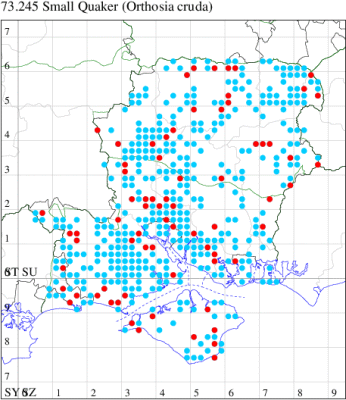
Records by year
Records by week (adult)
Records by week (larval)
Record Summary
VC10: Earliest: Cranmore, 07 Mar, 1 (CHic) Latest: Bonchurch, 30 Apr, 1 (JHa) Max count: Wootton Bridge, 18 Mar, 48 (DElm)
VC11: Earliest: Botley, 21 Feb, 1 (SLB) Latest: Milford-on-sea Nature Reserve, 10 May, 1 (GBro) Max count: Romsey, 16 Mar, 40 (NRJ)
VC12: Earliest: Pamber Forest, 21 Feb, 1 (GJD) Latest: Pamber Forest, 31 May, 4 (GJD) Max count: Basingstoke, 30 Mar, 155 (GAH)
73.247 [B&F: 2186] Powdered Quaker Orthosia gracilis ([Denis & Schiffermüller], 1775) - Common
Common in marshes, damp woodland and gardens throughout the British Isles, a species of conservation concern under the UK Biodiversity Action Plan. Widespread and still fairly common in Hampshire and on the Isle of Wight. Wingspan 35-42 mm. The main confusion species is Common Quaker O. cerasi, but the grainy, or powdered, appearance of O. gracilis is usually distinctive, and the innermost half of the reniform stigma is usually darker than the outermost half. Larva feeds on various woody and herbaceous plants, including Eared, Grey and Goat Willow, Black Poplar, Blackthorn, Bog-myrtle, Meadowsweet, Purple Loosestrife and Common Fleabane, over-wintering as a pupa.
Records prior to 2021
| Vice County | #Records | #Individuals | First Record | Last Record |
|---|---|---|---|---|
| 10 | 131 | 136 | 1951 | 2020 |
| 11 | 1377 | 1598 | 1950 | 2020 |
| 12 | 486 | 615 | 1951 | 2020 |
2021 records
| Vice County | #Records | #Individuals | Max Quantity |
|---|---|---|---|
| 10 | 9 | 11 | 2 |
| 11 | 23 | 28 | 3 |
| 12 | 14 | 15 | 2 |
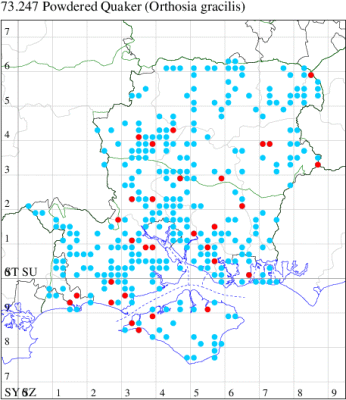
Records by year
Records by week (adult)
Records by week (larval)
Record Details
VC10: Totland, two, 03 Apr; one, 07 Apr; one, 08 Apr (RTer); Freshwater Bay, one, 14 Apr; one, 12 May (SDav); Cranmore, one, 09 Apr (CHic); Wootton Bridge, one, 15 Apr; two, 19 Apr; one, 04 May (DElm);
VC11: Marchwood, one, 02 May (TDCh); one, 24 Apr; one, 02 May (CTha); Woodlands, NF, present, 13 May (RBW); Romsey, one, 14 Apr (NRJ); Stanbrige Earls, two, 15 May (JRM); Winchester, one, 23 Apr (THW); Botley Wood, two, females, 09 Apr (RJD, MLO, ADT, DWal, KJW); Fareham, one, 08 Apr (ADT); Botley, one, 08 May; one, 11 May; one, 08 Apr; one, 14 May (SLB); Shirrell Heath, one, 16 Apr; three, 18 Apr; two, 02 May (LEdg); Portsmouth, one, 09 May (IRT); Old Winchester Hill, two, 16 Apr (RJD, MLO, ADT, DWal, KJW); Tuckton, Christchurch, one, 30 Mar (APar); Burton, nr Christchurch, one, 09 Apr (JStw); Sway, one, 05 Apr (DMui); Milford-on-sea Nature Reserve, one, to light, 08 May (GBro); Pennington, one, 08 Apr (RFC);
VC12: Chilbolton, one, 20 Apr; one, 10 May (SLE det. GCE); one, 13 May; Goodworth Clatford, one, 04 Apr; one, 04 Apr; Wherwell: SU3540: Westover Farm: SE of Flint Farm, one, 04 Apr; Barton Stacey, one, 31 Mar (GCE); Hinton Ampner, one, 25 Apr (ASD); Alton, two, 02 Apr; one, 08 Apr (BCA); one, 01 Apr (DBO); one, 25 Apr (NDP); Hammer Vale, one, 01 Apr (ASwa); Blackwater, one, 24 Apr (BDal)
73.248 [B&F: 2184] Northern Drab Orthosia opima (Hübner, [1809]) - Local
Local on saltmarshes, marshes, heathland, downland, golf courses and sand-dunes throughout much of the British Isles. In Hampshire and on the Isle of Wight much less common than formerly, with few recent records scattered through the three vice-counties, but perhaps overlooked amongst the myriad Clouded Drab. Wingspan 34-40 mm. Some of the darker, more unicolorous forms of Clouded Drab Orthosia incerta resemble the most common form of Northern Drab, f. brunnea but differ as follows: male antenna bipectinate; apex of forewing not pointed; subterminal line less conspicuous and less straight, particularly at extremities; cilia of hindwing pale fuscous (MBGBI Vol 9). Lead-coloured Drab Orthosia populeti is another possible confusion species, but that species has forewing with costa less straight and apex more rounded. Larva feeds on Sallow, Silver Birch, Downy Birch, Mugwort, Common Sea-lavender, herbaceous plants and woody plants, over-wintering as a pupa.
Records prior to 2021
| Vice County | #Records | #Individuals | First Record | Last Record |
|---|---|---|---|---|
| 10 | 15 | 8 | 1929 | 2016 |
| 11 | 59 | 127 | 1951 | 2019 |
| 12 | 40 | 50 | 1940 | 2020 |
2021 records
| Vice County | #Records | #Individuals | Max Quantity |
|---|---|---|---|
| 11 | 2 | 11 | 10 |
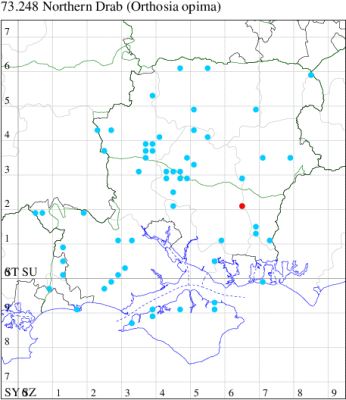
Records by year
Records by week (adult)
Records by week (larval)
Record Details
VC11: Old Winchester Hill, 10, at least 2 females, 16 Apr; one, 16 Apr (RJD, MLO, ADT, DWal, KJW)
73.249 [B&F: 2190] Hebrew Character Orthosia gothica (Linnaeus, 1758) - Common
Common often abundant, in all types of habitat throughout the British Isles. Widespread and common in Hampshire and on the Isle of Wight. Wingspan 30-40 mm. One of the commonest visitors to the light trap in early spring, but occasionally, around mid-May, appearing at the same time as the superficially similar Setaceous Hebrew Character Xestia c-nigrum. Larva polyphagous on a great many deciduous trees and shrubs, including Oak, Birch, Hawthorn, Sallow, Lime and Bilberry, and herbaceous plants such as Meadowsweet and Stinging Nettle, over-wintering as a pupa.
Records prior to 2021
| Vice County | #Records | #Individuals | First Record | Last Record |
|---|---|---|---|---|
| 10 | 1187 | 5345 | 1951 | 2020 |
| 11 | 12823 | 57316 | 1949 | 2020 |
| 12 | 4480 | 23823 | 1951 | 2020 |
2021 records
| Vice County | #Records | #Individuals | Max Quantity |
|---|---|---|---|
| 10 | 109 | 346 | 20 |
| 11 | 456 | 1110 | 25 |
| 12 | 195 | 552 | 12 |
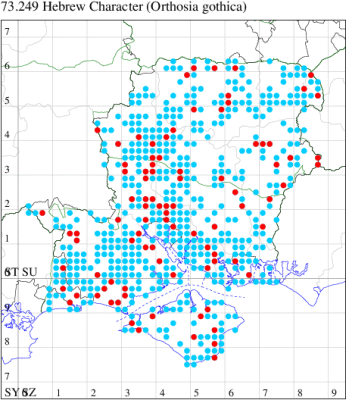
Records by year
Records by week (adult)
Records by week (larval)
Record Summary
VC10: Earliest: Cranmore, 22 Feb, 1 (CHic) Latest: Bonchurch, 07 Jun, 1 (JHa) Max count: Shanklin, 30 Mar, 20 (IOut)
VC11: Earliest: Botley, 19 Feb, 1 (SLB) Latest: Southampton, 10 Jun, 1 (MGP) Max count: Frogham, NF, 17 Mar, 25 (DBrd)
VC12: Earliest: Basingstoke, 20 Feb, 1 (MJW) Latest: Selborne, 27 May, 1 (CJP) Max count: Cholderton, 21 Mar, 12 (TJN, LFom, HEdm)
73.250 [B&F: 2189] Twin-spotted Quaker Anorthoa munda ([Denis & Schiffermüller], 1775) - Common
Common in broad-leaved woodland and gardens throughout England and Wales. Widespread and common in Hampshire and on the Isle of Wight. Wingspan 38-44 mm. Larva feeds on Sessile and Pedunculate Oak, Sallow, Aspen, Field Maple, Ash, Honeysuckle and Hop, over-wintering as a pupa.
Records prior to 2021
| Vice County | #Records | #Individuals | First Record | Last Record |
|---|---|---|---|---|
| 10 | 265 | 537 | 1951 | 2020 |
| 11 | 2267 | 4722 | 1949 | 2020 |
| 12 | 1007 | 2942 | 1951 | 2020 |
2021 records
| Vice County | #Records | #Individuals | Max Quantity |
|---|---|---|---|
| 10 | 19 | 32 | 5 |
| 11 | 56 | 77 | 6 |
| 12 | 36 | 55 | 6 |
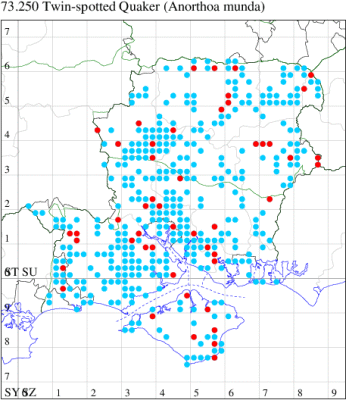
Records by year
Records by week (adult)
Records by week (larval)
Record Summary
VC10: Earliest: Bonchurch, 25 Feb, 1 (JHa) Latest: Shanklin, 20 Apr, 1 (IOut) Max count: Shanklin, 30 Mar, 5 (IOut)
VC11: Earliest: Romsey, 20 Feb, 1 (NRJ) Latest: Marchwood, 27 Apr, 1 (CTha) Max count: Hurn, 31 Mar, 6 (MJef)
VC12: Earliest: Farnborough, 21 Feb, 1 (MThop) Latest: Beech, 09 May, 1 (NDP) Max count: Cholderton, 21 Mar, 6 (TJN, LFom, HEdm)
73.252 [B&F: 2177] Hedge Rustic Tholera cespitis ([Denis & Schiffermüller], 1775) - Common
Common in rough grassland and gardens, but despite the name not hedgerows throughout the British Isles, a species of conservation concern under the UK Biodiversity Action Plan. In Hampshire and on the Isle of Wight continues to be recorded regularly and in good numbers only at Sandy Point, Hayling Island. Wingspan 34-40 mm. Larva feeds on various grasses, including Mat-grass and Wavy Hair-grass.
Records prior to 2021
| Vice County | #Records | #Individuals | First Record | Last Record |
|---|---|---|---|---|
| 10 | 117 | 215 | 1924 | 2020 |
| 11 | 901 | 1436 | 1949 | 2020 |
| 12 | 221 | 390 | 1951 | 2020 |
2021 records
| Vice County | #Records | #Individuals | Max Quantity |
|---|---|---|---|
| 10 | 6 | 11 | 4 |
| 11 | 34 | 53 | 6 |
| 12 | 33 | 125 | 32 |
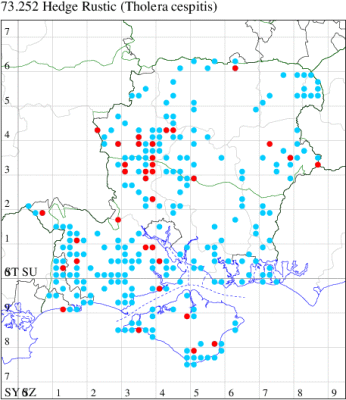
Records by year
Records by week (adult)
Records by week (larval)
Record Details
VC10: Freshwater Bay, three, 18 Sep (SDav); Newport, one, 05 Sep; one, 07 Sep; one, 15 Sep (DPl); Wydcombe, four, to light, 06 Sep (JRB, IOut); Shanklin, one, 07 Sep (IOut);
VC11: Ashley Heath, one, 21 Aug; six, 03 Sep; five, 10 Sep (SDut); Ringwood, one, field observation, 05 Sep (RGrv); Furzehill, NF, two, 07 Sep; one, 04 Sep; one, 08 Sep (SLoa); Marchwood, one, 25 Aug; one, 06 Sep (TDCh); one, 21 Aug; one, 31 Aug (CTha); Kings Somborne, three, 15 Sep; Ashley, two, 04 Sep; one, 04 Sep (GCE); Romsey, one, 30 Aug (NRJ); Broughton, one, 06 Sep; one, 06 Sep; Ashley, one, 04 Sep; one, 20 Aug; two, 04 Sep; Winter Down Copse, Little Somborne, two, 01 Sep; four, 01 Sep (GCE); Dibden Purlieu, one, 27 Aug; one, 28 Aug; one, 30 Aug; one, 31 Aug; one, 05 Sep; two, 08 Sep; one, 31 Aug; one, 05 Sep; one, 06 Sep; one, 08 Sep (RAC); Boscombe, one, 21 Aug (GBro); Needs Ore NNR, one, 09 Sep (CBut, SCol);
VC12: Over Wallop, one, 04 Sep (CMap); Cholderton, three, 10 Sep (TJN); Wherwell, one, 30 Aug; Little Somborne, two, 03 Sep; Chilbolton, one, 12 Sep (GCE); one, 16 Sep (SLE); Crawley, one, 03 Sep; Goodworth Clatford, one, 30 Aug; one, 30 Aug; Barton Stacey, nine, 29 Aug; one, 29 Aug; two, 29 Aug; five, 29 Aug; seven, 29 Aug; four, 29 Aug; three, 29 Aug; four, 29 Aug; one, 29 Aug; one, 02 Sep; four, 02 Sep; 19, 02 Sep; two, 02 Sep; one, 02 Sep; six, 02 Sep; four, 02 Sep; one, 02 Sep (GCE); Morn Hill, Winchester, two, 27 Aug (MJW, DAS, PDF); 32, 11 Sep (CBey, DAS, PDF); Pamber Forest, one, 08 Sep (GJD); Alton, one, 10 Sep (NDP); Whitehill, one, 05 Sep (ASto); Bordon, one, 03 Sep (AAll, RKin); Hammer Vale, one, 08 Sep (ASwa det. MJW)
73.253 [B&F: 2178] Feathered Gothic Tholera decimalis (Poda, 1761) - Common
Common on rough grassland, downland, woodland edges, parks and gardens throughout the British Isles, a species of conservation concern under the UK Biodiversity Action Plan. In Hampshire and on the Isle of Wight, there has undoubtedly been a substantial decline since the 1950s, when it was abundant on the north-east heaths and in the New Forest, but apparent increases in recent years, especially in 2006, hint at a partial recovery. Wingspan 38-48 mm. The main confusion species is Bordered Gothic Heliophobus reticulata, but in Feathered Gothic the male has strongly bipectinate antenna; forewing darker brown; lines, other than subterminal, inconspicuous; flies late August to September. Larva feeds on various species of grass, including Mat-grass and Sheep's-fescue, over-wintering as an egg.
Records prior to 2021
| Vice County | #Records | #Individuals | First Record | Last Record |
|---|---|---|---|---|
| 10 | 54 | 112 | 1951 | 2020 |
| 11 | 1034 | 2087 | 1947 | 2020 |
| 12 | 522 | 1661 | 1951 | 2020 |
2021 records
| Vice County | #Records | #Individuals | Max Quantity |
|---|---|---|---|
| 10 | 7 | 36 | 18 |
| 11 | 48 | 146 | 50 |
| 12 | 33 | 83 | 21 |
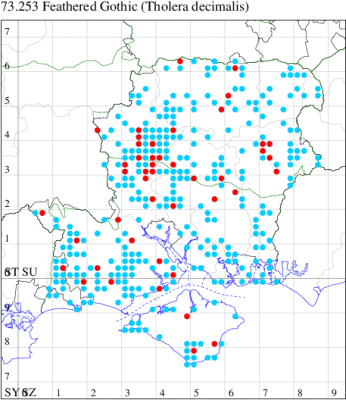
Records by year
Records by week (adult)
Records by week (larval)
Record Details
VC10: Newport, one, 04 Sep; one, 05 Sep; one, 07 Sep; one, 12 Sep (DPl); Wydcombe, 18, more than the total number I've recorded in the last eight years, 06 Sep (IOut); 13, to light, 06 Sep (JRB, IOut); Shanklin, one, 07 Sep (IOut);
VC11: Ashley Heath, one, 10 Sep (SDut); Furzehill, NF, two, 06 Sep (SLoa); Burley, NF, one, 17 Sep (NDP); Woodlands, NF, present, 04 Sep (RBW); Ashley, two, 04 Sep (GCE); Romsey, one, 28 Aug; one, 05 Sep; one, 06 Sep (NRJ); Broughton, four, 06 Sep; four, 06 Sep; eight, 06 Sep; one, 06 Sep; six, 06 Sep; two, 06 Sep; four, 06 Sep; seven, 06 Sep; seven, 06 Sep; Houghton, one, 05 Sep; Stockbridge Down NT, one, 05 Sep; Ashley, five, 04 Sep; one, 04 Sep; one, 04 Sep; four, 04 Sep; Winter Down Copse, Little Somborne, one, 01 Sep; two, 01 Sep; three, 01 Sep; Crawley, one, 14 Sep (GCE); Dibden Purlieu, one, 01 Sep; one, 05 Sep; one, 08 Sep; one, 02 Sep; one, 03 Sep; one, 06 Sep; one, 08 Sep (RAC); Blackfield, one, 04 Sep (SJJ); Allbrook, one, 02 Sep; one, 03 Sep; one, 04 Sep; one, 05 Sep; one, 06 Sep (SIng); Upham, one, male, 25 Aug (RJD); West Meon, 50, 50+, some of which were nectaring on marjoram at night, 03 Sep; six, 6+, including 2 females, 03 Sep (RJD, MLO, DWal, KJW); Thorney Hill, Bransgore, one, 08 Sep; one, 11 Sep; one, 12 Sep (JFen); Sway, present, 05 Sep (DMui); Needs Ore NNR, one, 09 Sep (CBut, SCol);
VC12: Cholderton, three, 10 Sep (TJN); Wherwell, one, 30 Aug; one, 30 Aug; Little Somborne, 10, 03 Sep; Chilbolton, three, 09 Sep; one, 12 Sep; Crawley, two, 14 Sep; three, 03 Sep (GCE); Anna Valley, Andover, two, 01 Sep (TJN, LFom); Goodworth Clatford, one, 18 Sep; one, 18 Sep; Crawley, one, 03 Sep; one, 07 Sep; four, 07 Sep; Barton Stacey, two, 02 Sep; three, 02 Sep; one, 02 Sep; three, 02 Sep; two, 02 Sep (GCE); Burghclere, three, 29 Aug (PBlk); Morn Hill, Winchester, 21, 11 Sep (CBey, DAS, PDF); Hinton Ampner, one, 30 Aug; two, 05 Sep (ASD); Kempshott, one, 04 Sep (GAH); Basingstoke, one, 03 Sep (MJW); Pamber Forest, two, 08 Sep (GJD); Alton, two, 06 Sep (BCA); one, to artificial light, 05 Sep (DBO); Chawton, present, field observation, 02 Sep (DAS); Alton, one, 08 Sep (EFig); one, 08 Sep (NDP); West Worldham, one, 10 Sep; Empshott, one, 30 Aug (CJP)
73.254 [B&F: 2176] Antler Moth Cerapteryx graminis (Linnaeus, 1758) - Common
Common in upland grassland, moorland and downland throughout much of the British Isles. In Hampshire and on the Isle of Wight widespread but usually rather uncommon in grassy places in marshes and on heaths, chalk downs and commons. Some of its favoured habitat has been lost and many of the locations shown on the map refer to single specimens and has decreased alarmingly in the last twenty years. Wingspan male 27-32 mm, female 35-39 mm. Larva feeds on various grasses, including Sheep's-fescue, Mat-grass and Purple Moor-grass, over-wintering as an egg.
Records prior to 2021
| Vice County | #Records | #Individuals | First Record | Last Record |
|---|---|---|---|---|
| 10 | 57 | 63 | 1951 | 2020 |
| 11 | 154 | 179 | 1951 | 2020 |
| 12 | 145 | 223 | 1951 | 2020 |
2021 records
| Vice County | #Records | #Individuals | Max Quantity |
|---|---|---|---|
| 11 | 2 | 2 | 1 |
| 12 | 1 | 1 | 1 |
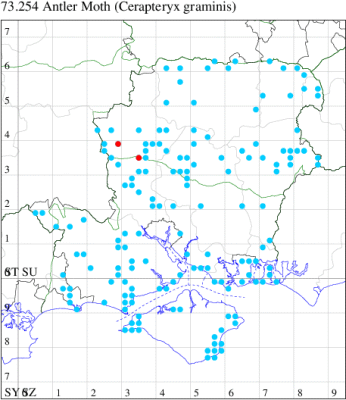
Records by year
Records by week (adult)
Records by week (larval)
Record Details
VC11: Stockbridge Down NT, one, 18 Jul (GCE);
VC12: Over Wallop, one, 29 Aug (CMap)
73.255 [B&F: 2145] Nutmeg Anarta trifolii (Hufnagel, 1766) - Common
Common in gardens, waste ground, downland, fens and open woodland throughout the British Isles. Widespread and common in Hampshire and on the Isle of Wight. Wingspan 23-39 mm. Main features are: subterminal line yellowish white with two teeth to the termen (which together make a clear W-mark), dorsal lobe of reniform stigma usually dark, orbicular stigma usually pale, claviform stigma outlined darker or completely dark; but variable and can be confused with f. obscura of Dusky Brocade Apamea remissa, as well as Confused Apamea furva. Larva feeds on various herbaceous plants, including Goosefoot and Orache, over-wintering as a pupa.
Records prior to 2021
| Vice County | #Records | #Individuals | First Record | Last Record |
|---|---|---|---|---|
| 10 | 116 | 100 | 1951 | 2020 |
| 11 | 1939 | 2845 | 1950 | 2020 |
| 12 | 435 | 555 | 1949 | 2020 |
2021 records
| Vice County | #Records | #Individuals | Max Quantity |
|---|---|---|---|
| 10 | 9 | 11 | 3 |
| 11 | 61 | 65 | 3 |
| 12 | 34 | 42 | 3 |
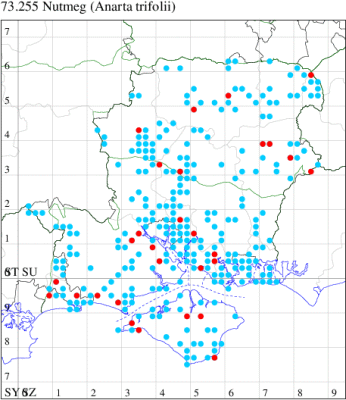
Records by year
Records by week (adult)
Records by week (larval)
Record Summary
VC10: Earliest: Freshwater Bay, 12 May, 1 (SDav) Latest: Newport, 01 Sep, 1 (DPl) Max count: Freshwater Bay, 04 Aug, 3 (SDav)
VC11: Earliest: Botley, 26 May, 1 (SLB) Latest: Totton, 09 Oct, 1 (LHan) Max count: Fareham, 29 Jul, 3 (KJW)
VC12: Earliest: Basingstoke, 01 Jun, 1 (MJW) Latest: Whitehill, 01 Sep, 1 (ASto) Max count: Basingstoke, 10 Jun, 3 (MJW)
73.257 [B&F: 2142] Beautiful Yellow Underwing Anarta myrtilli (Linnaeus, 1761) - Common
Common on heathland and moorland throughout much of the British Isles. In Hampshire and on the Isle of Wight common in the New Forest and in north-east Hampshire. Wingspan 24-28 mm. The moth is usually diurnal, but is recorded occasionally at light. Larva feeds on terminal shoots of Heather and Bell Heather, over-wintering as a pupa.
Records prior to 2021
| Vice County | #Records | #Individuals | First Record | Last Record |
|---|---|---|---|---|
| 10 | 16 | 12 | 1943 | 2020 |
| 11 | 533 | 1050 | 1951 | 2020 |
| 12 | 102 | 148 | 1951 | 2020 |
2021 records
| Vice County | #Records | #Individuals | Max Quantity |
|---|---|---|---|
| 11 | 6 | 7 | 2 |
| 12 | 6 | 7 | 2 |
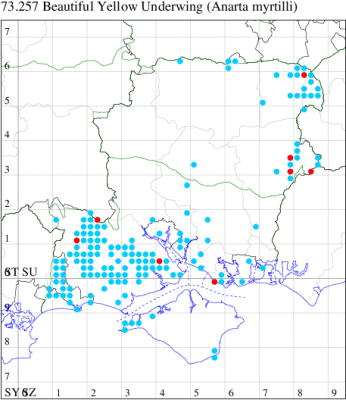
Records by year
Records by week (adult)
Records by week (larval)
Record Details
VC11: Furzehill, NF, one, 07 Sep (SLoa); Ibsley Common, larva, one, swept, 29 Jul; larva, one, swept, 29 Jul (MSP, AMD, RFox); RSPB Franchises Lodge, NF, larva, one, field observation, 10 Aug (LBee det. PRea); Dibden Purlieu, one, 11 Aug (RAC); Browndown Coastal Ranges, two, 20 Aug (RJD, MLO, DWal, KJW);
VC12: Longmoor Inclosure, Liss, one, field observation, 20 Jul (FHay); Whitehill, one, 15 Jul; two, 19 Jul; one, 20 Aug (ASto); Liphook, Hampshire, one, 19 Jul (RForr); Yateley Common, one, field observation, 29 Jul (PBam)
73.261 [B&F: 2150] Grey Arches Polia nebulosa (Hufnagel, 1766) - Common
Common in broad-leaved woodland, areas with scattered trees and gardens throughout the British Isles. Widespread and still fairly common in Hampshire. Not recorded from the Isle of Wight since 1983. Wingspan 46-58 mm. The main confusion species is Silvery Arches P. trimaculosa, but P. nebulosa differs, for example, in having a distinct, longitudinal tornal dash. Larva feeds on various deciduous trees and shrubs, including Hazel, Downy and Silver Birch, Honeysuckle, Sallow and Bramble.
Records prior to 2021
| Vice County | #Records | #Individuals | First Record | Last Record |
|---|---|---|---|---|
| 10 | 32 | 30 | 1856 | 2020 |
| 11 | 992 | 1123 | 1951 | 2020 |
| 12 | 556 | 828 | 1951 | 2020 |
2021 records
| Vice County | #Records | #Individuals | Max Quantity |
|---|---|---|---|
| 10 | 2 | 2 | 1 |
| 11 | 22 | 30 | 6 |
| 12 | 12 | 13 | 2 |
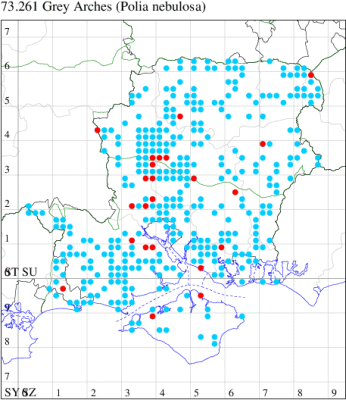
Records by year
Records by week (adult)
Records by week (larval)
Record Details
VC10: Cranmore, one, 30 Jun (JMar det. JRB); Osborne Valley Walk, one, 22 Jul (IOut);
VC11: Marchwood, one, 30 Jun (TDCh); one, 17 Jul (CTha); Woodlands, NF, present, 30 Jun (RBW); Ashurst, two, 01 Jul (RFC); Long Down, Shootash, one, 26 Jun (PHog, P&CHop det. PHog); Romsey, one, 07 Jul; one, 09 Jul; two, 13 Jul (MBak); Kings Somborne, one, 29 Jun; one, 29 Jun (GCE); Romsey, one, 22 Jun (NRJ); Kings Somborne, two, 29 Jun; Winter Down Copse, Little Somborne, one, 30 Jun; one, 30 Jun; two, 30 Jun (GCE); Titchfield Haven NNR, one, 25 Jun (RJD, DWal, KJW, RCar, DHun); Wickham, one, to light, 09 Jul (KCok, RJD, MLO, ADT, KJW); one, 23 Jun; one, 06 Jul (JRDS); West Meon, six, 02 Jul; one, 02 Jul (RJD, MLO, ADT, DWal, KJW); Hurn, one, 27 Jun (MJef);
VC12: Cholderton, one, 02 Jul (TJN, LFom, HEdm); Little Somborne, one, 12 Jul; Crawley, one, 28 Jun; one, 28 Jun; two, 28 Jun; one, 12 Jul; Little Somborne, one, 24 Jun; Crawley, one, 25 Jun (GCE); Whitchurch, one, field observation, 01 Jul (SBro); Morn Hill, Winchester, one, 17 Jul (CBey, DAS, PDF); Alton, one, 18 Jul (DBO); Blackwater, one, 29 Jun (BDal)
73.263 [B&F: 2157] Light Brocade Lacanobia w-latinum (Hufnagel, 1766) - Local
Local on calcareous grassland, heaths and open woodland throughout the British Isles. Widespread and common in Hampshire and on the Isle of Wight. Wingspan 37-42 mm. Unmistakable. Larva feeds on various wood plants, including Broom, Dyer's Greenweed and Bramble, and herbaceous plants, including Redshank, over-wintering as a pupa.
Records prior to 2021
| Vice County | #Records | #Individuals | First Record | Last Record |
|---|---|---|---|---|
| 10 | 103 | 104 | 1951 | 2020 |
| 11 | 2003 | 2900 | 1950 | 2020 |
| 12 | 945 | 1802 | 1951 | 2020 |
2021 records
| Vice County | #Records | #Individuals | Max Quantity |
|---|---|---|---|
| 10 | 12 | 16 | 4 |
| 11 | 88 | 138 | 15 |
| 12 | 47 | 89 | 12 |
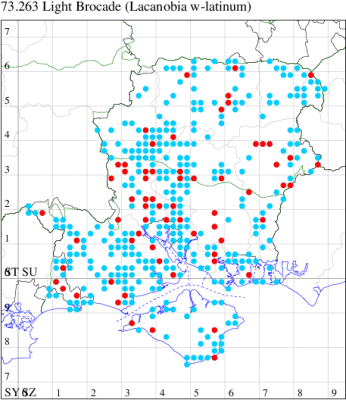
Records by year
Records by week (adult)
Records by week (larval)
Record Summary
VC10: Earliest: Bonchurch, 29 May, 1 (JHa) Latest: Brook Down, 07 Jul, 1 (PBar) Max count: Bonchurch, 01 Jun, 4 (JHa)
VC11: Earliest: Ashley Heath, 09 May, 1 (SDut) Latest: Totton, 17 Jul, 1 (LHan) Max count: Hilltop, The Hangers, 12 Jun, 15 (SIng)
VC12: Earliest: Teg Down, Winchester, 16 May, 1 (CKni) Latest: Whitehill, 30 Jun, 1 (ASto) Max count: Morn Hill, Winchester, 12 Jun, 12 (CBey, DAS, PDF et al)
73.264 [B&F: 2158] Pale-shouldered Brocade Lacanobia thalassina (Hufnagel, 1766) - Common
Common in woodland, scrubland, moorland and fens throughout the British Isles. Widespread and fairly common in Hampshire and on the Isle of Wight. Wingspan 38-44 mm. Dark reddish-brown, often with pale irroration, eyes hairy (visible with hand lens) and pale shoulders (not unique to this species); resembles Beautiful Brocade L. contigua (diagonal white band across forewing), Clouded Brindle Apamea epomidion (eye hairless), Dusky Brocade Apamea remissa (eye hairless) and Dark Brocade Blepharita adusta (no pale basal patch). Larva feeds on a wide range of woody plants, including Pedunculate and Sessile Oak, Hawthorn, Apple, Sallow, Aspen and Honeysuckle, over-wintering as a pupa.
Records prior to 2021
| Vice County | #Records | #Individuals | First Record | Last Record |
|---|---|---|---|---|
| 10 | 28 | 8 | 1856 | 2018 |
| 11 | 448 | 339 | 1951 | 2020 |
| 12 | 195 | 163 | 1951 | 2020 |
2021 records
| Vice County | #Records | #Individuals | Max Quantity |
|---|---|---|---|
| 11 | 5 | 6 | 2 |
| 12 | 1 | 1 | 1 |
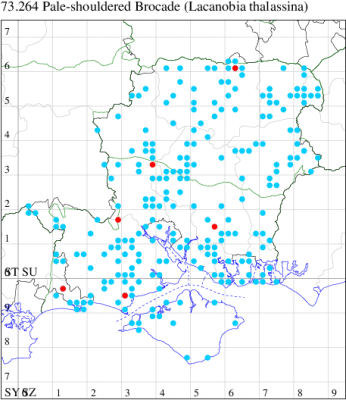
Records by year
Records by week (adult)
Records by week (larval)
Record Details
VC11: Winter Down Copse, Little Somborne, one, 02 Jun (GCE); Shirrell Heath, one, 26 May (LEdg); Hurn, one, 10 Jun (MJef); Pennington, one, 26 May; two, 28 May (RFC);
VC12: Pamber Forest, one, 11 Jun (GJD)
73.266 [B&F: 2159] Dog's Tooth Lacanobia suasa ([Denis & Schiffermüller], 1775) - Local
Local in saltmarshes, grassland, moorland and farmland throughout England, including Hampshire and the Isle of Wight, and virtually confined to the coast, with only a thin scattering of records inland. Wingspan 32-42 mm. Diagnostic feature is a distinct, often solid, dark tooth-like mark in centre of forewing (MBGBI Vol 9). Larva feeds on various herbaceous plants, including Common Sea-lavender, Greater Plantain and Goosefoot, over-wintering as a pupa.
Records prior to 2021
| Vice County | #Records | #Individuals | First Record | Last Record |
|---|---|---|---|---|
| 10 | 31 | 26 | 1856 | 2018 |
| 11 | 1033 | 1809 | 1948 | 2020 |
| 12 | 13 | 9 | 1951 | 2015 |
2021 records
| Vice County | #Records | #Individuals | Max Quantity |
|---|---|---|---|
| 10 | 2 | 2 | 1 |
| 11 | 6 | 8 | 3 |
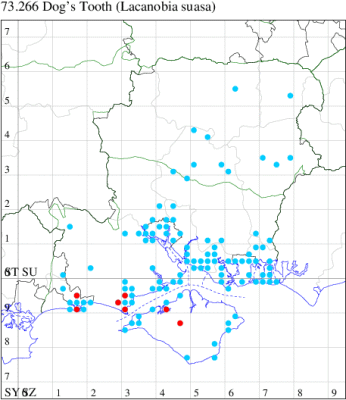
Records by year
Records by week (adult)
Records by week (larval)
Record Details
VC10: Plaish, Carisbrooke, one, 25 Jul (KRyl); Newtown NNR, one, 02 Jul (PBar);
VC11: Hengistbury Head, one, 11 Aug (MJef); Burton, nr Christchurch, one, 30 Jul (JStw); Milford on Sea, one, 06 Aug; one, 17 Aug; Keyhaven, three, 15 Aug (MMcM); Pennington, one, 28 May (RFC)
73.267 [B&F: 2160] Bright-line Brown-eye Lacanobia oleracea (Linnaeus, 1758) - Common
Common in gardens, heathland, saltmarshes, woodland rides and a wide range of other habitats throughout much of the British Isles. In Hampshire and on the Isle of Wight widespread and common in all three vice-counties. Wingspan 34-44 mm. The most likely confusion species is Dog's Tooth Lacanobia suasa, which is duller brown and has a characteristic central tooth-mark on forewing, even in the darkest forms it is usually just possible to see the subterminal line and the short, black basal streak (MBGBI Vol 9). Larva polyphagous, feeding mainly on herbaceous plants, but with an apparent natural preference for orache and goosefoot, also on Stinging Nettle, Fat-hen, Broad-leaved Willowherb, Rosebay Willowherb, St John's-wort, Traveller's-joy, Black-bindweed, Tamarisk, English Elm, Hazel, Hop and Reed Sweet-grass, over-wintering as a pupa.
Records prior to 2021
| Vice County | #Records | #Individuals | First Record | Last Record |
|---|---|---|---|---|
| 10 | 1284 | 3326 | 1951 | 2020 |
| 11 | 18412 | 46273 | 200 | 2020 |
| 12 | 3188 | 8578 | 1951 | 2020 |
2021 records
| Vice County | #Records | #Individuals | Max Quantity |
|---|---|---|---|
| 10 | 139 | 328 | 13 |
| 11 | 361 | 553 | 8 |
| 12 | 82 | 119 | 8 |
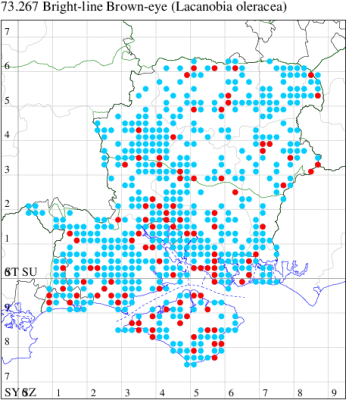
Records by year
Records by week (adult)
Records by week (larval)
Record Summary
VC10: Earliest: Bonchurch, 10 May, 1 (JHa) Latest: Freshwater, 26 Oct, 1 (DCoo) Max count: Freshwater, 23 Jul, 13 (DCoo)
VC11: Earliest: Totton, 08 May, 1 (LHan) Latest: Lee, nr Nursling, 25 Sep, 1 (CTha) Max count: Swaythling, Southampton, 18 Jul, 8 (MEdg)
VC12: Earliest: Basingstoke, 12 May, 1 (GAH) Latest: Basingstoke, 06 Sep, 2 (MJW) Max count: Basingstoke, 14 Jul, 8 (MJW)
73.270 [B&F: 2155] Dot Moth Melanchra persicariae (Linnaeus, 1761) - Common
Common in a wide range of habitats, including gardens, hedgerows and woodland throughout England, Wales and southern Scotland, a species of conservation concern under the UK Biodiversity Action Plan. Widespread and common in Hampshire and on the Isle of Wight. Wingspan 38-50 mm. Larva polyphagous, feeding on herbaceous plants such as Stinging Nettle, Broad-leaved Dock and White Clover, and woody plants such as Black Currant, Ivy, Hazel and Elder, over-wintering as a pupa.
Records prior to 2021
| Vice County | #Records | #Individuals | First Record | Last Record |
|---|---|---|---|---|
| 10 | 350 | 715 | 1951 | 2020 |
| 11 | 2196 | 3154 | 1949 | 2020 |
| 12 | 1175 | 2308 | 1949 | 2020 |
2021 records
| Vice County | #Records | #Individuals | Max Quantity |
|---|---|---|---|
| 10 | 18 | 29 | 4 |
| 11 | 23 | 22 | 2 |
| 12 | 13 | 13 | 1 |
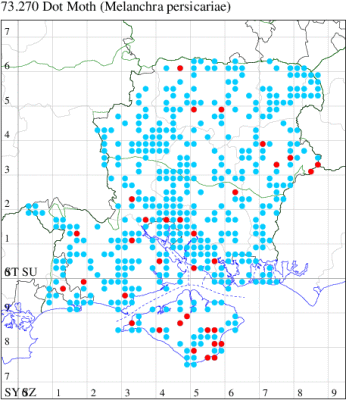
Records by year
Records by week (adult)
Records by week (larval)
Record Details
VC10: Totland, two, 24 Jul; two, 26 Jul (RTer); Mottistone Down, one, 07 Jul (PBar); Plaish, Carisbrooke, one, 25 Jul (KRyl); Newport, one, 13 Jul (DPl); Wydcombe, one, to light, 08 Jul (JRB, IOut); one, 08 Jul (IOut); Rew Down, Ventnor, one, 15 Jul (PBar); Wheelers Bay, one, 01 Sep; one, 13 Sep (ABut); Bonchurch, one, 02 Jul; one, 03 Jul; one, 14 Jul (JHa); Haseley Manor, four, 19 Jul; Shanklin, four, 18 Jul (IOut); Alverstone, one, 11 Jul; one, 27 Jul (DFai); Shanklin Upper Chine, four, 18 Jul (IOut);
VC11: Frogham, NF, one, 22 Jul; one, 03 Aug (DBrd); Woodlands, NF, present, 07 Jul (RBW); Upton, one, 21 Jul (PHac); Stanbrige Earls, one, 09 Jul (JRM); Dibden Purlieu, one, 25 Jul (RAC); Swaythling, Southampton, one, 09 Jul; two, 24 Jul; one, 27 Jul (MEdg); Itchen Valley CP, one, 16 Jul (CTha); Brownwich cliffs, one, 16 Jul (MLO, RJD, KJW); Fareham, one, 08 Aug (ADT); Botley, one, 16 Jul; one, 09 Aug; one, 20 Jul; present, field observation, 24 Sep (SLB); Wickham, one, 06 Jul (JRDS); West Meon, one, 02 Jul (RJD, MLO, ADT, DWal, KJW); Hengistbury Head, one, 12 Jul (SDar); Hurn, one, 19 Jul (MJef); Thorney Hill, Bransgore, one, 04 Aug (JFen); Pennington, one, 14 Jul; one, 15 Jul (RFC);
VC12: Burghclere, one, 17 Jul (PBlk); Overton, one, 19 Jul (MSin); Kempshott, one, 18 Jul (GAH); Alton, one, field observation, 26 Aug (EFig); Selborne, one, 27 Jul; one, 27 Jul (CJP); Whitehill, one, 08 Jul; one, 15 Jul; one, 26 Jul (ASto); Liphook, Hampshire, one, 19 Jul (RForr); Hammer Vale, one, 14 Jul; one, 19 Jul; one, 28 Jul (ASwa)
73.271 [B&F: 2163] Broom Moth Ceramica pisi (Linnaeus, 1758) - Common
Common on heathland, moorland and in gardens, and on a wide range of other habitats throughout much of the British Isles, a species of conservation concern under the UK Biodiversity Action Plan. In Hampshire and on the Isle of Wight most frequent in heathy places in the New Forest and north-east Hampshire, occasional elsewhere. Wingspan 33-42 mm. The most likely confusion species is Bright-line Brown-eye Lacanobia oleracea, which has a straighter, whiter subterminal line. Larva feeds on Heather, Bracken, Broom, Bramble, Sallow and Sea Buckthorn, over-wintering as a pupa.
Records prior to 2021
| Vice County | #Records | #Individuals | First Record | Last Record |
|---|---|---|---|---|
| 10 | 11 | 2 | 1856 | 2016 |
| 11 | 743 | 1029 | 1951 | 2020 |
| 12 | 137 | 107 | 1951 | 2020 |
2021 records
| Vice County | #Records | #Individuals | Max Quantity |
|---|---|---|---|
| 11 | 12 | 16 | 4 |
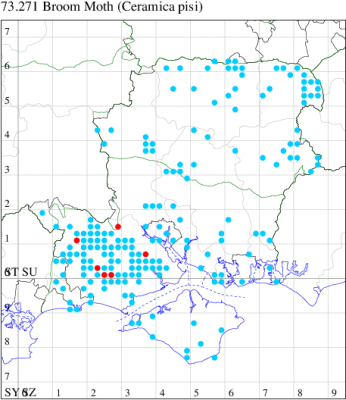
Records by year
Records by week (adult)
Records by week (larval)
Record Details
VC11: Furzehill, NF, one, 21 Jun; four, 29 Jun; one, 15 Jul; one, 18 Jul (SLoa); Ibsley Common, larva, one, swept, 29 Jul (MSP, AMD, RFox); Burley, NF, one, 21 Jul (NDP); Wilverley Plain, NF, two, 24 Jun; one, 24 Jun; Hinchelsea Moor, NF, one, 22 Jun (PBar); Cadnam Common, NF, larva, one, field observation, 15 Sep (LGal); Yew Tree Heath, NF, larva, one, field observation, 14 Sep (TDCh); Hengistbury Head, one, 14 Jul (SDar)
73.273 [B&F: 2147] Shears Hada plebeja (Linnaeus, 1761) - Common
Common on heathland, sand-dunes, downland and open woodland throughout the British Isles. Widespread and common in Hampshire and on the Isle of Wight. Wingspan 28-38 mm. The characteristic white marks adjacent to the orbicular stigma and bordered with black resemble the points of an open pair of shears. Larva feeds on various herbaceous plants, including Smooth Hawk's-beard, Mouse-ear Hawkweed and Lucerne, over-wintering as a pupa.
Records prior to 2021
| Vice County | #Records | #Individuals | First Record | Last Record |
|---|---|---|---|---|
| 10 | 441 | 1248 | 1930 | 2020 |
| 11 | 1583 | 3026 | 1949 | 2020 |
| 12 | 824 | 1444 | 1951 | 2020 |
2021 records
| Vice County | #Records | #Individuals | Max Quantity |
|---|---|---|---|
| 10 | 57 | 161 | 15 |
| 11 | 43 | 138 | 32 |
| 12 | 30 | 55 | 25 |
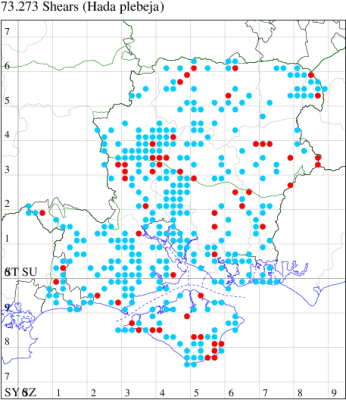
Records by year
Records by week (adult)
Records by week (larval)
Record Summary
VC10: Earliest: Bonchurch, 17 May, 1 (JHa) Latest: Rew Down, Ventnor, 15 Jul, 1 (PBar) Max count: Freshwater Bay, 30 Jun, 15 (PBar)
VC11: Earliest: Broughton, 27 May, 6 (GCE) Latest: Broughton, 08 Jul, 3 (GCE) Max count: Old Winchester Hill, 11 Jun, 32 (RJD, MLO, DWal, KJW)
VC12: Earliest: Little Somborne, 28 May, 1 (GCE) Latest: Crawley, 28 Jun, 1 (GCE) Max count: Morn Hill, Winchester, 12 Jun, 25 (CBey, DAS, PDF et al)
73.274 [B&F: 2154] Cabbage Moth Mamestra brassicae (Linnaeus, 1758) - Common
Common in gardens, allotments, open woodland and a wide range of other habitats throughout the British Isles. In Hampshire and on the Isle of Wight there is no real sign of any decline in recent years, still widespread and common. Wingspan 34-50 mm. Distinctive white edge to reniform stigma; has been confused with Dot Moth Melanchra persicariae, but much less obviously black and white then this species. Larva polyphagous, but with a preference for Brassica, causing sufficient damage to be a serious pest in some areas, and over-wintering as a pupa or larva.
Records prior to 2021
| Vice County | #Records | #Individuals | First Record | Last Record |
|---|---|---|---|---|
| 10 | 311 | 369 | 1900 | 2020 |
| 11 | 3945 | 5016 | 1951 | 2020 |
| 12 | 650 | 675 | 1951 | 2020 |
2021 records
| Vice County | #Records | #Individuals | Max Quantity |
|---|---|---|---|
| 10 | 29 | 42 | 4 |
| 11 | 111 | 160 | 8 |
| 12 | 32 | 33 | 2 |
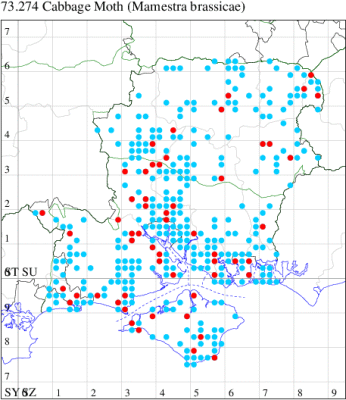
Records by year
Records by week (adult)
Records by week (larval)
Record Summary
VC10: Earliest: Bonchurch, 30 Apr, 1 (JHa) Latest: Newport, 15 Sep, 1 (DPl) Max count: Freshwater, 25 Aug, 4 (DCoo)
VC11: Earliest: Burton, nr Christchurch, 08 May, 1 (JStw) Latest: Portchester, 23 Sep, 1 (DH-J) Max count: Marchwood, 04 Sep, 10 (CTha)
VC12: Earliest: Basingstoke, 01 Jun, 1 (MJW) Latest: Basingstoke, 18 Sep, 1 (MJW) Max count: Basingstoke, 16 Aug, 2 (MJW)
73.276 [B&F: 2166] Campion Sideridis rivularis (Fabricius, 1775) - Common
Common in a wide range of habitats, including roadside verges, damp meadows, moorland and sea cliffs throughout the British Isles; widely distributed in Hampshire and on the Isle of Wight, but reported much less often than formerly. Wingspan 30-36 mm. The main confusion species is Lychnis H. bicruris, which see for difference. Larva feeds on seeds of White Campion, Red Campion, Sea Campion and Ragged Robin.
Records prior to 2021
| Vice County | #Records | #Individuals | First Record | Last Record |
|---|---|---|---|---|
| 10 | 49 | 35 | 1951 | 2019 |
| 11 | 812 | 804 | 1949 | 2020 |
| 12 | 360 | 342 | 1949 | 2020 |
2021 records
| Vice County | #Records | #Individuals | Max Quantity |
|---|---|---|---|
| 10 | 1 | 1 | 1 |
| 11 | 4 | 7 | 4 |
| 12 | 10 | 9 | 1 |
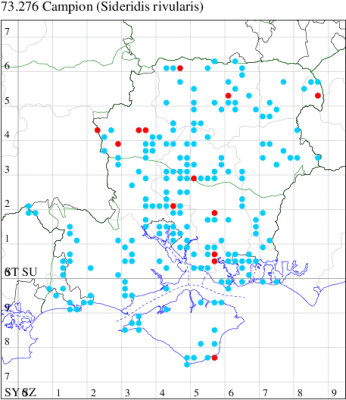
Records by year
Records by week (adult)
Records by week (larval)
Record Details
VC10: Wheelers Bay, one, 03 Jun (ABut);
VC11: Allbrook, one, 22 Jul (SIng); Fareham, one, 21 Jul (IMcP); one, to light, 29 Jul (KJW); Hilltop, The Hangers, four, 12 Jun (SIng det. DPH);
VC12: Over Wallop, one, 14 Aug (CMap); Cholderton, one, 02 Jul (TJN, LFom, HEdm); Anna Valley, Andover, one, 20 Jul (TJN, LFom); Goodworth Clatford, one, 09 Aug; one, 11 Aug (JMor); Burghclere, one, 17 Jul (PBlk); Morn Hill, Winchester, one, 12 Jun (CBey, DAS, PDF et al); present, 12 Jun (DAS); Basingstoke, one, 19 Jul (MJW); Farnborough, one, 26 Jul (KBW)
73.279 [B&F: 2164] Broad-barred White Hecatera bicolorata (Hufnagel, 1766) - Common
Common in sand-dunes, shingle beaches, rough grassland, chalk downland and gardens throughout the British Isles. Widespread and common in Hampshire and on the Isle of Wight. Wingspan 28-35 mm. Broad dark grey or blackish central band on white or greyish-white forewing, which has a straight leading edge, usually makes this an unmistakable species, but occasionally ground-colour is grey (MBGBI Vol 9). Larva feeds on flower buds and flowers of Beaked, Marsh, Rough and Smooth Hawk's-beard, and Mouse-ear Hawkweed, over-wintering as a pupa.
Records prior to 2021
| Vice County | #Records | #Individuals | First Record | Last Record |
|---|---|---|---|---|
| 10 | 95 | 85 | 1951 | 2020 |
| 11 | 669 | 597 | 1949 | 2020 |
| 12 | 349 | 342 | 1948 | 2020 |
2021 records
| Vice County | #Records | #Individuals | Max Quantity |
|---|---|---|---|
| 10 | 12 | 13 | 2 |
| 11 | 10 | 10 | 1 |
| 12 | 14 | 16 | 2 |
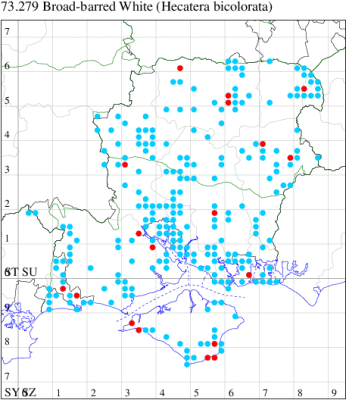
Records by year
Records by week (adult)
Records by week (larval)
Record Details
VC10: Totland, one, 24 Jun; one, 21 Jul; one, 22 Jul (RTer); Freshwater, one, 07 Jul (DCoo); Freshwater Bay, one, 15 Jul (SDav); Rew Down, Ventnor, one, 13 Jul (PBar); Bonchurch, one, 11 Jun; one, 15 Jun; one, 30 Jun; two, 02 Jul; one, 14 Jul (JHa); Shanklin, one, 02 Jul (IOut);
VC11: Marchwood, one, 09 Jul (CTha); Totton, one, 01 Jul; one, 08 Jul; one, 14 Jul (LHan); Broughton, one, 08 Jul; one, 25 Jul (GCE); Bishop's Waltham, one, field observation, 23 Jun (DTru); Portsmouth, one, 04 Jul (IRT); Hurn, one, 11 Jun (MJef); Burton, nr Christchurch, one, 22 Jul (JStw);
VC12: Burghclere, one, 17 Jul (PBlk); Basingstoke, two, 01 Jul; one, 22 Jul; one, 25 Jul (MJW); one, 14 Jul (RHil); Alton, one, 16 Jun; one, field observation, 17 Jun; one, 13 Jul; one, field observation, 14 Jul (EFig); Whitehill, one, 16 Jun; one, 28 Jun; one, 04 Jul; two, 08 Jul (ASto); Farnborough, one, 02 Jul (MThop)
73.280 [B&F: 2165] Small Ranunculus Hecatera dysodea ([Denis & Schiffermüller], 1775) - RDBK
A Red Data Book species, on roadside verges, chalk pits, gardens, allotments and rough ground in parts of south-eastern England. Locally common at the end of the 19th Century, the species declined rapidly in the first half of the 20th Century, disappearing from the British Isles completely by 1941. It has subsequently recolonised our island and is becoming increasingly common again: following two in Gravesend, Kent, in 1997, a resident population became established in north-west Kent from 1998 onwards. There were also records in Essex and Suffolk in 1999. The first modern day records in Hampshire were in 2009, with individuals in Southsea, Fleet and Andover; 2010 saw six further sightings, ten in 2011, with similar numbers annually thereafter. The county population has two distinct centres, one in the north-east reflecting dispersion from recently established populations in Surrey, and along the south-east coast; a first for the island in 2020 was no great surprise. Larvae were found in the Andover area in 2013. Wingspan 32-36 mm. Larva feeds on Prickly Lettuce and Great Lettuce, over-wintering as a pupa.
Records prior to 2021
| Vice County | #Records | #Individuals | First Record | Last Record |
|---|---|---|---|---|
| 10 | 1 | 1 | 2020 | 2020 |
| 11 | 115 | 265 | 2006 | 2020 |
| 12 | 17 | 30 | 2009 | 2018 |
2021 records
| Vice County | #Records | #Individuals | Max Quantity |
|---|---|---|---|
| 11 | 15 | 30 | 8 |
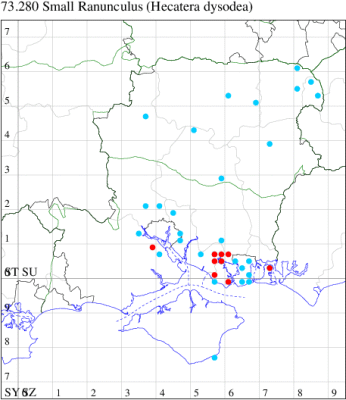
Records by year
Records by week (adult)
Records by week (larval)
Record Details
VC11: Marchwood, one, 29 Jun (CTha); Lee-on-Solent, one, 21 Aug (IHrg det. MJW); Fareham, one, 15 Jul; one, 30 Jul (ADT); one, male, 11 Jul; two, to light, 23 Jul; larva, two, on host-plant, 03 Oct; larva, one, field observation, large larva on Lactuca, 07 Oct; larva, eight, on host-plant, 2 larvae on a Lactuca virosa on 26.vii.2021; this had risen to at least 8 at pretty much all stages of growth by 1.viii, 01 Aug (KJW); larva, two, on host-plant, 31 Jul; larva, one, on host-plant, one larva on a small isolated Lactuca on Lysses Path at SU585063, 31 Jul (RJD); larva, one, on host-plant, salvaged one 2nd instar larva in High Street, 09 Oct; Portsdown, larva, four, on host-plant, almost full-grown larvae on one shrivelled-up infloresence of a Lactuca plant, 20 Sep (KJW); Northney, Hayling, one, bred ex larvae, bred from a larva from JWP's Northney garden on Prickly Lettuce, 04 Jun (GRE); Gosport, larva, three, on host-plant, 26 Aug (RJD)
73.281 [B&F: 2173] Lychnis Hadena bicruris (Hufnagel, 1766) - Common
Common in gardens, farmland, hedgerows and woodland, and on roadside verges and sand-dunes throughout the British Isles; widespread and reasonably common in Hampshire and on the Isle of Wight. Wingspan 30-40 mm. The main confusion species is Campion H. rivularis, which often has a purple hue when freshly emerged; on Lychnis the upper stigmata are usually clearly apart dorsally, and subterminal line joins dorsum at an angle of about 45°, clearly inclined to and almost parallel with termen (MBGBI Vol 9). Larva feeds on seeds of White Campion, Red Campion and Sweet-William, over-wintering as a pupa.
Records prior to 2021
| Vice County | #Records | #Individuals | First Record | Last Record |
|---|---|---|---|---|
| 10 | 230 | 246 | 1951 | 2020 |
| 11 | 2238 | 2336 | 1951 | 2020 |
| 12 | 468 | 422 | 1949 | 2020 |
2021 records
| Vice County | #Records | #Individuals | Max Quantity |
|---|---|---|---|
| 10 | 15 | 16 | 2 |
| 11 | 40 | 45 | 2 |
| 12 | 13 | 12 | 1 |
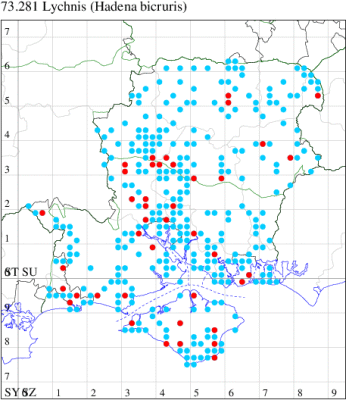
Records by year
Records by week (adult)
Records by week (larval)
Record Details
VC10: Totland, one, 22 Jun; one, 27 Jul (RTer); Brighstone Bay, one, to light, 29 May (MCrm); Plaish, Carisbrooke, two, 24 Jul (KRyl); Kingston, one, 24 Jun (ENes); Wheelers Bay, one, 20 Jul (ABut); Bonchurch, one, 29 Apr; one, 18 May; one, 19 May; one, 10 Jun (JHa); Shanklin, one, 08 Jun; one, 02 Jul (IOut); Alverstone, one, 13 May; one, 19 May (DFai); East Cowes, one, 29 May (TWhi);
VC11: Ashley Heath, one, 30 Jun (SDut); Marchwood, one, 16 Jun; one, 20 Jun; one, 09 Jul; one, 26 Jul (CTha); Totton, one, 28 May; one, 01 Aug; one, 04 Aug; one, 31 Aug; two, 01 Sep (LHan); Upton, one, 13 Aug (PHac); Woodley, one, 11 Jun; one, 13 Aug (NBin); Romsey, one, 23 Jun; one, 30 Jun (MBak); Broughton, one, 25 Jul; one, 25 Jul; Winter Down Copse, Little Somborne, one, 02 Jun; one, 19 Jul (GCE); Stanbrige Earls, one, 28 Jul (JRM); Swaythling, Southampton, two, 30 May; one, 05 Jun; two, 02 Jul; one, 09 Aug; one, 19 Aug (MEdg); Allbrook, one, 11 Jun (SIng); Crawley, one, 05 Jun (GCE); Fareham, one, 17 Aug (MLO); one, 02 Jun; two, 10 Jun; one, to light, 17 Aug (KJW); Botley, one, 30 Jul (SLB); Portsmouth, two, 11 Aug (IRT); Hurn, one, 03 Jul (MJef); Christchurch, one, 05 Sep (PHug); Burton, nr Christchurch, one, 04 Jun; one, 17 Aug (JStw); New Milton, one, 11 Jun (RPH); Pennington, one, 29 Jun (RFC); Southsea, one, 29 May (JRL det. IRT);
VC12: Little Somborne, one, 12 Jul; Crawley, one, 25 Aug; one, 10 Aug (GCE); Morn Hill, Winchester, present, 12 Jun (DAS); Hinton Ampner, one, 01 Jun (ASD); Basingstoke, one, 02 Jun (MJW); one, 12 Jun (RHil); Alton, one, 26 Jul (BCA); one, 22 Aug (DBO); Whitehill, one, 31 May; one, 02 Jun; one, 14 Aug (ASto); Farnborough, one, 22 Aug (KBW)
73.282 [B&F: 2170] Varied Coronet Hadena compta ([Denis & Schiffermüller], 1775) - Common
Common in calcareous grassland and gardens throughout much of southern England. In Hampshire mainly a garden species and first recorded in 1983, since when it has spread rapidly. As at 2015 there were just two records from the Isle of Wight. Wingspan 28-34 mm. The main confusion species is Marbled Coronet H. confusa which is larger, with more ample forewing, median fascia incomplete, diagonal, from orbicular stigma to tornus, and whitish blotches at each extremity of subterminal line (MBGBI Vol 9). Larva feeds on seedpods of Bladder Campion and, in gardens, Sweet-William, over-wintering as a pupa.
Records prior to 2021
| Vice County | #Records | #Individuals | First Record | Last Record |
|---|---|---|---|---|
| 10 | 3 | 2 | 1981 | 2015 |
| 11 | 393 | 341 | 1984 | 2020 |
| 12 | 186 | 225 | 1983 | 2020 |
2021 records
| Vice County | #Records | #Individuals | Max Quantity |
|---|---|---|---|
| 11 | 5 | 5 | 1 |
| 12 | 6 | 6 | 1 |
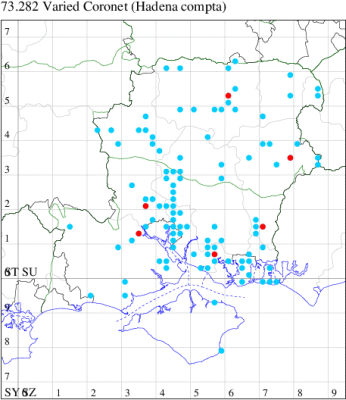
Records by year
Records by week (adult)
Records by week (larval)
Record Details
VC11: Totton, one, field observation, 11 Jul (SSto); one, 15 Jun (LHan); Romsey, one, 25 Jun (MBak); Fareham, one, 26 Jun (KJW); Horndean*, one, 02 Jul (PHog);
VC12: Basingstoke, one, 25 Jun; one, 01 Jul (MJW); Whitehill, one, 11 Jun; one, 16 Jun; one, 19 Jun; one, 02 Jul (ASto)
73.283 [B&F: 2171] Marbled Coronet Hadena confusa (Hufnagel, 1766) - Local
Local on calcareous grassland in southern England and along the coasts of Britain and Ireland. In Hampshire and on the Isle of Wight it has never been a common species, but still a sporadic visitor to light almost anywhere, although distinctly uncommon in the New Forest. Wingspan 33-39 mm. The main confusion species is Varied Coronet Hadena compta, which see for differences. Larva feeds on seedpods of Sea Campion, Bladder Campion and Rock Sea-spurrey, over-wintering as a pupa.
Records prior to 2021
| Vice County | #Records | #Individuals | First Record | Last Record |
|---|---|---|---|---|
| 10 | 5 | 1 | 1951 | 2015 |
| 11 | 122 | 95 | 1951 | 2020 |
| 12 | 53 | 37 | 1950 | 2020 |
2021 records
| Vice County | #Records | #Individuals | Max Quantity |
|---|---|---|---|
| 11 | 3 | 2 | 1 |
| 12 | 2 | 1 | 1 |
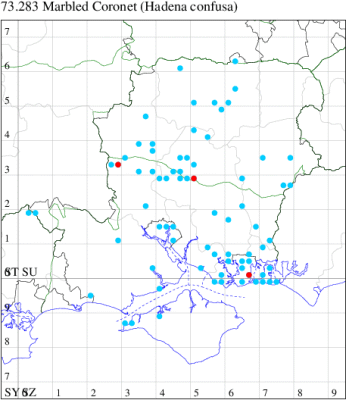
Records by year
Records by week (adult)
Records by week (larval)
Record Details
VC11: Broughton Down, one, 12 Jun (MBot, DTay det. MBot); Portsmouth, one, 02 Jun (IRT);
VC12: Morn Hill, Winchester, present, 12 Jun (DAS); one, 12 Jun (CBey, DAS, PDF et al)
73.286 [B&F: 2167] Tawny Shears Hadena perplexa ([Denis & Schiffermüller], 1775) - Local
Found in dry open areas throughout much of England and western Scotland. In Hampshire and on the Isle of Wight very local and increasingly coastal in occurrence, albeit with several inland in 2004. Wingspan 27-36 mm. Similar to Lychnis Hadena bicruris which is larger, ground colour brown to dark brown, apex of forewing more obtuse, dorsal extremity of subterminal line parallel to termen; pale examples of Tawny Shears are superficially similar to Sand Dart Agrotis ripae, which is likely to occur in some of the same southern coastal localities, however Sand Dart has longer, narrower forewing and silky white hindwing, sometimes darkened along veins, but without a dark border (MBGBI Vol 9). Larva feeds on Bladder Campion, White Campion, Nottingham Catchfly, Sea Campion and Rock Sea-spurrey, over-wintering as a pupa.
Records prior to 2021
| Vice County | #Records | #Individuals | First Record | Last Record |
|---|---|---|---|---|
| 10 | 25 | 18 | 1951 | 2019 |
| 11 | 201 | 214 | 1949 | 2020 |
| 12 | 42 | 22 | 1950 | 2014 |
2021 records
| Vice County | #Records | #Individuals | Max Quantity |
|---|---|---|---|
| 10 | 4 | 4 | 1 |
| 12 | 1 | 1 | 1 |
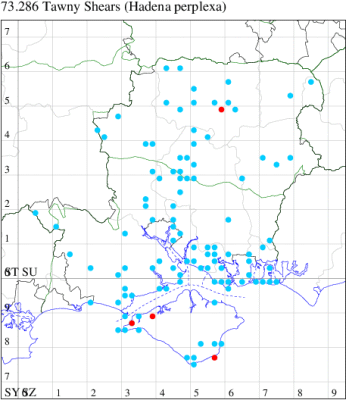
Records by year
Records by week (adult)
Records by week (larval)
Record Details
VC10: Totland, one, 28 May (RTer); Cranmore, one, 13 Jun (CHic); Wheelers Bay, one, 04 Aug; one, 07 Sep (ABut);
VC12: Kempshott, one, 03 Aug (GAH)
73.289 [B&F: 2196] Striped Wainscot Mythimna pudorina ([Denis & Schiffermüller], 1775) - Local
Local in marshes, river-banks, damp areas, fens and boggy heathland throughout much of England and southern Wales. In Hampshire locally common on damp heathland in the New Forest and in the north-east, and along the Test and Itchen valleys, and locally elsewhere; remarkably scarce on the Isle of Wight with only a few scattered records. Wingspan 36-43 mm. Distinguished by the shape of the wing in which the apex, termen and costa are more rounded than similar related species. Larva feeds on various grasses, including Common Reed, Purple Moor-grass and Reed Canary-grass.
Records prior to 2021
| Vice County | #Records | #Individuals | First Record | Last Record |
|---|---|---|---|---|
| 10 | 4 | 3 | 1981 | 2009 |
| 11 | 378 | 345 | 1951 | 2020 |
| 12 | 153 | 256 | 1940 | 2020 |
2021 records
| Vice County | #Records | #Individuals | Max Quantity |
|---|---|---|---|
| 10 | 1 | 1 | 1 |
| 11 | 4 | 4 | 2 |
| 12 | 3 | 3 | 1 |
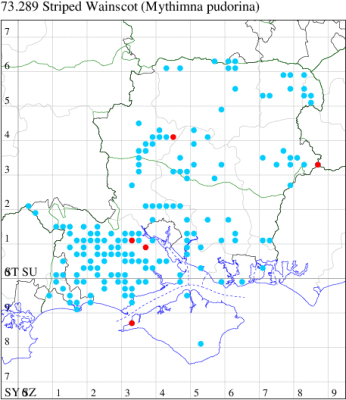
Records by year
Records by week (adult)
Records by week (larval)
Record Details
VC10: Freshwater, one, 16 Jul (DCoo);
VC11: Marchwood, one, 18 Jul; two, 24 Jul; one, 31 Jul (TDCh); Woodlands, NF, present, 30 Jun (RBW);
VC12: Bullington, one, 16 Jul (GCE); Hammer Vale, one, 19 Jul; one, 22 Jul (ASwa)
73.290 [B&F: 2192] Brown-line Bright-eye Mythimna conigera ([Denis & Schiffermüller], 1775) - Common
Common but perhaps in long-term decline, in grassland, woodland edges and rough meadows throughout the British Isles. In Hampshire and on the Isle of Wight widely distributed but not particularly common, having declined considerably in recent years. Wingspan 32-38 mm. Unmistakable. Larva feeds on various grasses, including Cock's-foot and Common Couch.
Records prior to 2021
| Vice County | #Records | #Individuals | First Record | Last Record |
|---|---|---|---|---|
| 10 | 29 | 33 | 1951 | 2020 |
| 11 | 559 | 880 | 1949 | 2020 |
| 12 | 307 | 405 | 1949 | 2020 |
2021 records
| Vice County | #Records | #Individuals | Max Quantity |
|---|---|---|---|
| 10 | 2 | 2 | 1 |
| 11 | 8 | 8 | 1 |
| 12 | 1 | 1 | 1 |
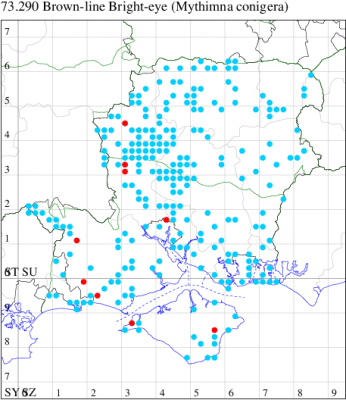
Records by year
Records by week (adult)
Records by week (larval)
Record Details
VC10: Freshwater, one, 20 Jun (DCoo); Alverstone, one, 30 Jul (DFai);
VC11: Furzehill, NF, one, 28 Jul (SLoa); Broughton, one, 08 Jul; one, 25 Jul; one, 25 Jul; one, 25 Jul (GCE); Swaythling, Southampton, one, 27 Jul (MEdg); Thorney Hill, Bransgore, one, 10 Jul (JFen); New Milton, one, 25 Aug (RPH);
VC12: The Hawk Conservancy Trust, Weyhill, one, 26 Jun (MJhn)
73.291 [B&F: 2199] Common Wainscot Mythimna pallens (Linnaeus, 1758) - Nationally Scarce
Common in grassland, woodland rides and gardens throughout the British Isles. Widespread and common in Hampshire and on the Isle of Wight. Wingspan 32-40 mm. Confusion species include Smoky Wainscot M. impura, which see, and Mathew's Wainscot M. favicolor, which occurs only in saltmarshes from Hampshire to Suffolk. Larva feeds on various grasses, including Tufted Hair-grass, Annual Meadow-grass, Common Couch and Cock's-foot.
Records prior to 2021
| Vice County | #Records | #Individuals | First Record | Last Record |
|---|---|---|---|---|
| 10 | 1281 | 3341 | 1856 | 2020 |
| 11 | 9804 | 30381 | 1800 | 2020 |
| 12 | 4554 | 25087 | 1948 | 2020 |
2021 records
| Vice County | #Records | #Individuals | Max Quantity |
|---|---|---|---|
| 10 | 163 | 638 | 41 |
| 11 | 501 | 1199 | 38 |
| 12 | 322 | 1528 | 108 |
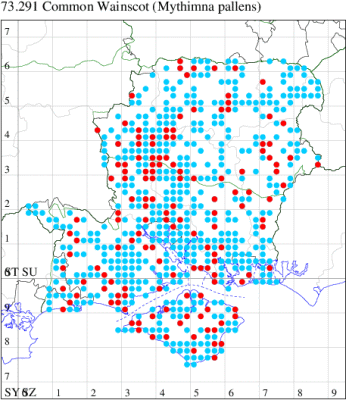
Records by year
Records by week (adult)
Records by week (larval)
Record Summary
VC10: Earliest: Wootton Bridge, 12 May, 1 (DElm) Latest: Ryde, 15 Oct, 1 (IGam) Max count: Freshwater, 03 Sep, 41 (DCoo)
VC11: Earliest: Stanbrige Earls, 28 May, 1 (JRM) Latest: Lee, nr Nursling, 15 Oct, 1 (CTha) Max count: Broughton, 06 Sep, 38 (GCE)
VC12: Earliest: Hinton Ampner, 30 May, 1 (ASD) Latest: Barton Stacey, 12 Oct, 1 (GCE) Max count: West Worldham, 10 Sep, 108 (CJP)
73.293 [B&F: 2198] Smoky Wainscot Mythimna impura (Hübner, [1808]) - Common
Common in grassland, woodland rides, gardens and sand-dunes throughout the British Isles. Widespread and common in Hampshire and on the Isle of Wight. Wingspan 31-38 mm. The main confusion species is Common Wainscot M. pallens, but differs from this species especially in the dusky grey underwing, which can be seen by gently lifting up the forewing with forceps. Larva feeds on various grasses, including Cock's-foot and Common Reed.
Records prior to 2021
| Vice County | #Records | #Individuals | First Record | Last Record |
|---|---|---|---|---|
| 10 | 460 | 1478 | 1951 | 2020 |
| 11 | 7344 | 23661 | 1948 | 2020 |
| 12 | 2773 | 10773 | 1951 | 2020 |
2021 records
| Vice County | #Records | #Individuals | Max Quantity |
|---|---|---|---|
| 10 | 61 | 225 | 17 |
| 11 | 207 | 501 | 17 |
| 12 | 80 | 173 | 15 |
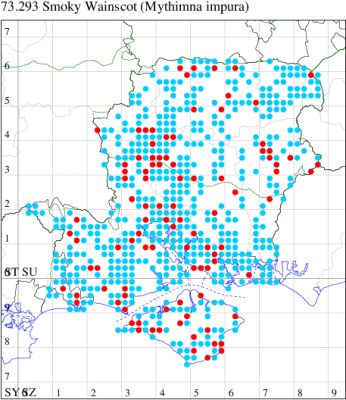
Records by year
Records by week (adult)
Records by week (larval)
Record Summary
VC10: Earliest: Totland, 23 Jun, 1 (RTer) Latest: Totland, 29 Aug, 3 (RTer) Max count: Plaish, Carisbrooke, 25 Jul, 17 (KRyl)
VC11: Earliest: Fareham, 28 May, 1 (KJW) Latest: Pennington, 24 Sep, 1 (RFC) Max count: Stockbridge Down NT, 18 Jul, 17 (GCE)
VC12: Earliest: Chilbolton, 23 Jun, 1 (SLE) Latest: Kempshott, 22 Sep, 1 (GAH) Max count: Bullington, 16 Jul, 15 (GCE)
73.294 [B&F: 2197] Southern Wainscot Mythimna straminea (Treitschke, 1825) - Local
Local in reed-beds and fens throughout much of England, south of a line from the Bristol Channel to the Wash; less common farther north, but occurs locally in mid-Wales, Cheshire, Yorkshire and Cumbria. In Hampshire Locally common in marshes and reed-beds with occasional wanderers elsewhere. On the Isle of Wight, recorded infrequently along the Eastern and Western Yar valleys. Wingspan 32-40 mm. The most likely confusion species are: Common Wainscot M. pallens, which lacks the straight termen, pointed apex and row of postmedian dots on the forewing; Obscure Wainscot M. obsoleta, which has a more narrow forewing with an even more pointed apex, and subterminal line of dots usually complete and parallel to termen; and Shore Wainscot M. litoralis, Devonshire Wainscot M. putrescens and Cosmopolitan M. loreyi, which all have pure white hindwings, as does the unrelated but not dissimilar Reed Dagger Simyra albovenosa (MBGBI Vol 9). Larva feeds on Common Reed and Reed Canary-grass.
Records prior to 2021
| Vice County | #Records | #Individuals | First Record | Last Record |
|---|---|---|---|---|
| 10 | 86 | 356 | 1951 | 2020 |
| 11 | 874 | 1733 | 1948 | 2020 |
| 12 | 151 | 346 | 1951 | 2020 |
2021 records
| Vice County | #Records | #Individuals | Max Quantity |
|---|---|---|---|
| 10 | 6 | 14 | 6 |
| 11 | 17 | 55 | 8 |
| 12 | 7 | 11 | 4 |
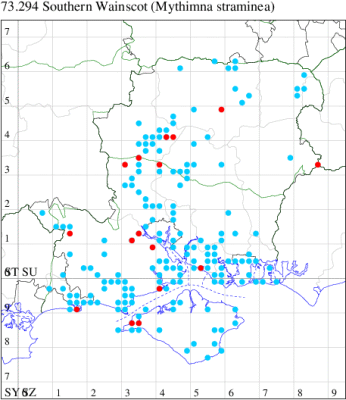
Records by year
Records by week (adult)
Records by week (larval)
Record Details
VC10: Totland, four, 26 Jul (RTer); Afton Marsh, six, 03 Jul; Freshwater, one, 01 Jul; one, 07 Jul; one, 29 Jun; one, 08 Jul (PBar);
VC11: Fordingbridge, one, 30 Jul (SCT); Marchwood, one, 13 Aug (CTha); Woodlands, NF, present, 26 Jul (RBW); Totton, one, 01 Aug (LHan); Broughton, one, 25 Jul; Stockbridge Down NT, three, 18 Jul; one, 18 Jul; two, 18 Jul; four, 18 Jul (GCE); Titchfield Haven NNR, six, 25 Jun (RJD, DWal, KJW, RCar, DHun); Hengistbury Head, four, 05 Aug; three, 11 Aug; 14, 11 Aug (MJef); Needs Ore NNR, three, 19 Aug (PCra); seven, 18 Aug (CNB); four, 19 Aug (PCra);
VC12: Crawley, one, 04 Aug; Barton Stacey, one, 16 Jul; Bullington, one, 16 Jul; two, 16 Jul; four, 16 Jul (GCE); Kempshott, one, 22 Sep (GAH); Hammer Vale, one, 28 Jul (ASwa)
73.295 [B&F: 2195] Delicate Mythimna vitellina (Hübner, [1808]) - Migrant
Common immigrant from grassland in the Canary Islands and southern Europe, appearing on the south coast in most years in sufficient numbers to breed. In Hampshire and on the Isle of Wight most frequently recorded on the coast, becoming increasingly uncommon inland, with approximately one in six of received Hampshire records being from vice-county 12. Wingspan 36-43 mm. Fairly unmistakable. Larva feeds on various grasses, such as Cock's-foot and Annual Meadow-grass, unable to over-winter in Britain in significant numbers.
Records prior to 2021
| Vice County | #Records | #Individuals | First Record | Last Record |
|---|---|---|---|---|
| 10 | 376 | 1906 | 1951 | 2020 |
| 11 | 664 | 955 | 1951 | 2020 |
| 12 | 127 | 232 | 1951 | 2020 |
2021 records
| Vice County | #Records | #Individuals | Max Quantity |
|---|---|---|---|
| 10 | 54 | 176 | 17 |
| 11 | 17 | 16 | 1 |
| 12 | 12 | 14 | 2 |
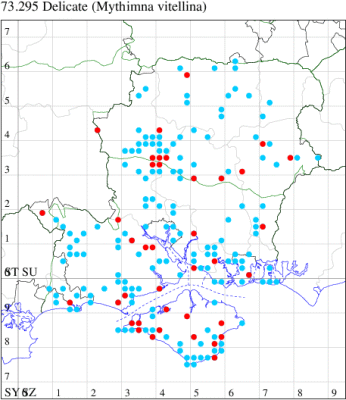
Records by year
Records by week (adult)
Records by week (larval)
Record Details
VC10: Totland, two, 26 Jun; one, 22 Jul; one, 01 Sep; one, 22 Oct; one, 27 Oct (RTer); Freshwater, one, 18 Sep; one, 06 Oct; three, 10 Oct; one, 12 Oct (DCoo); Afton Marsh, one, 03 Jul (PBar); Freshwater Bay, four, 29 Jun; one, 30 Aug; three, 07 Oct; three, 13 Oct (SDav); Freshwater, one, 29 Jun; two, 01 Jul; one, 01 Jul; two, 03 Jul; two, 06 Jul (PBar); Brook, three, 25 Sep; two, 29 Sep; two, 01 Oct; seven, 06 Oct; four, 07 Oct (DWes & REJ); Mottistone Down, three, 28 Jun (PBar); Newport, one, 13 Oct (DPl); Walter's Copse, Newtown, one, 02 Jul (PBar); Wheelers Bay, two, 12 Sep; one, 17 Oct (ABut); Bonchurch, one, 21 Jun; one, 30 Jun; one, 23 Sep; one, 24 Sep; two, 03 Oct; one, 14 Oct; two, 16 Oct; two, 08 Nov (JHa); Rookley, one, 11 Oct (JRB); Shanklin, one, 06 Oct; one, 09 Nov; one, 16 Nov (IOut); Ryde, 17, 09 Oct; 10, 10 Oct; nine, 11 Oct; 12, 12 Oct; 14, 13 Oct; six, 14 Oct; 16, 15 Oct; five, 16 Oct; two, 17 Oct; five, 18 Oct; two, 19 Oct (IGam); Lake, one, 11 Oct; four, 14 Oct (TSte);
VC11: Marchwood, one, 30 Jun (TDCh); one, 22 Jul (CTha); Woodlands, NF, present, 08 Jul (RBW); Crawley, one, 14 Sep; one, 17 Jul (GCE); Chandlers Ford, one, 30 Jun (KArb); Brownwich cliffs, one, female, 17 Sep (RJD, MLO, DWal, KJW det. KJW); Fareham, one, 09 Oct (ADT); Botley, one, 12 Nov; one, 19 Oct; one, 31 Oct (SLB); Portsmouth, one, 18 Oct (IRT); Horndean*, one, 18 Sep (PHog); Tuckton, Christchurch, one, 09 Oct (APar); Milford on Sea, one, 11 Sep (MMcM); Pennington, one, 08 Oct (RFC); Needs Ore NNR, one, 09 Sep (CBut, SCol);
VC12: Cholderton, one, 10 Sep (TJN); Crawley, one, 08 Nov; one, 14 Sep; one, 25 Sep (GCE); Ecchinswell, one, 14 Nov (MTay, CSul); Morn Hill, Winchester, one, 08 Oct (CBey, DAS, PDF); Hinton Ampner, one, 09 Jul; two, 09 Oct (ASD); Ropley, two, 06 Oct (TJN, LFom); Alton, one, 28 Oct (BCA); one, 19 Sep (EFig); Whitehill, one, 28 Jun (ASto)
73.296 [B&F: 2203] White-speck Mythimna unipuncta (Haworth, 1809) - Recent colonist
A low-level immigrant from grassland in northern Europe, appearing on the south coast in recent years in sufficient numbers to breed; this hitherto very scarce migrant has been reported with increasing frequency on the Isle of Wight and in south Hampshire, but it is still quite infrequent, and there are very few records from north Hampshire. Wingspan 41-48 mm. Characterised by combination of median line, apical dash, and dark smoky brown hindwing. Larva feeds on various grasses, such as Common Couch and Cock's-foot, unable to over-winter in significant numbers.
Records prior to 2021
| Vice County | #Records | #Individuals | First Record | Last Record |
|---|---|---|---|---|
| 10 | 110 | 250 | 1951 | 2020 |
| 11 | 169 | 259 | 1951 | 2020 |
| 12 | 11 | 4 | 1951 | 2016 |
2021 records
| Vice County | #Records | #Individuals | Max Quantity |
|---|---|---|---|
| 10 | 5 | 6 | 2 |
| 11 | 1 | 1 | 1 |
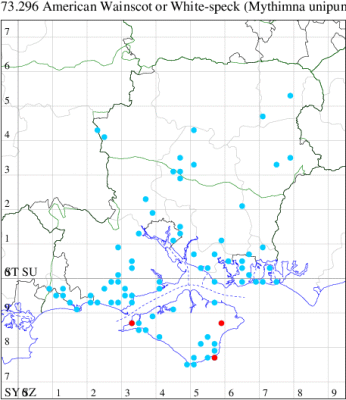
Records by year
Records by week (adult)
Records by week (larval)
Record Details
VC10: Totland, one, 26 Dec (RTer); Bonchurch, one, 27 Sep; two, 13 Nov; two, 28 Dec (JHa); Ryde, one, 18 Oct (IGam);
VC11: Hengistbury Head, one, 14 Jul (SDar)
73.297 [B&F: 2194] White-point Mythimna albipuncta ([Denis & Schiffermüller], 1775) - Migrant
Common immigrant from northern Europe, appearing in southern England, and in recent years an increasingly common resident which continues to extend its range northwards, probably as a result of the increase in temperatures in the region. In Hampshire and on the Isle of Wight most common on the coast, but frequently encountered across the region. Wingspan 34-38 mm. The most likely confusion species is Clay Mythimna ferrago, which is usually larger, has the reniform spot less rounded and the subterminal fascia clearly dotted (MBGBI Vol 9). Larva feeds on Common Couch, Cock's-foot and various grasses.
Updated: July 2020, status
Records prior to 2021
| Vice County | #Records | #Individuals | First Record | Last Record |
|---|---|---|---|---|
| 10 | 985 | 2417 | 1951 | 2020 |
| 11 | 7414 | 16051 | 1951 | 2020 |
| 12 | 1331 | 3447 | 1951 | 2020 |
2021 records
| Vice County | #Records | #Individuals | Max Quantity |
|---|---|---|---|
| 10 | 150 | 581 | 50 |
| 11 | 528 | 1245 | 29 |
| 12 | 221 | 612 | 41 |
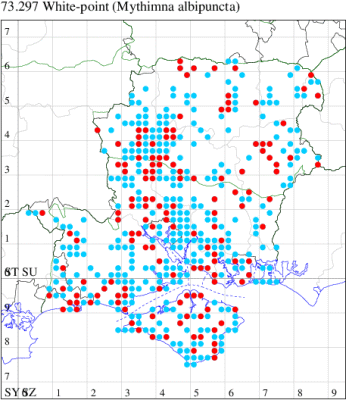
Records by year
Records by week (adult)
Records by week (larval)
Record Summary
VC10: Earliest: Bonchurch, 10 May, 1 (JHa) Latest: Freshwater, 23 Oct, 1 (DCoo) Max count: Totland, 01 Sep, 50 (RTer)
VC11: Earliest: Portsmouth, 17 May, 1 (IRT) Latest: Fareham, 27 Oct, 1 (IMcP) Max count: Pennington, 03 Sep, 29 (RFC)
VC12: Earliest: Crawley, 31 May, 1 (GCE) Latest: Anna Valley, Andover, 10 Oct, 1 (TJN, LFom) Max count: Cholderton, 10 Sep, 41 (TJN)
73.298 [B&F: 2193] Clay Mythimna ferrago (Fabricius, 1787) - Common
Common in a wide range of habitats, including gardens, marshes, river-banks and open woodland throughout the British Isles. Widespread and common in Hampshire and on the Isle of Wight. Wingspan 36-44 mm. Similar to White-point M. albipuncta, and sharing that species' black blotch on abdomen of male, but larger and plainer. Larva feeds on various grasses, including Annual, Smooth and Wood Meadow-grass, and Cock's-foot.
Records prior to 2021
| Vice County | #Records | #Individuals | First Record | Last Record |
|---|---|---|---|---|
| 10 | 431 | 994 | 1951 | 2020 |
| 11 | 5738 | 8860 | 1948 | 2020 |
| 12 | 1646 | 3212 | 1951 | 2020 |
2021 records
| Vice County | #Records | #Individuals | Max Quantity |
|---|---|---|---|
| 10 | 45 | 109 | 12 |
| 11 | 135 | 179 | 6 |
| 12 | 43 | 46 | 3 |
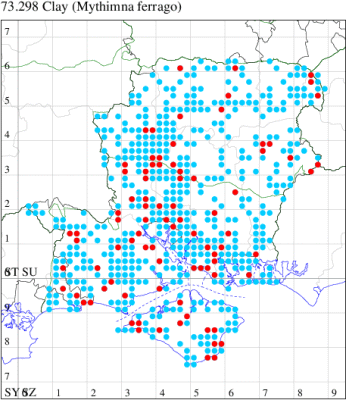
Records by year
Records by week (adult)
Records by week (larval)
Record Summary
VC10: Earliest: Freshwater Bay, 26 Jun, 1 (PBar) Latest: Totland, 27 Aug, 2 (RTer) Max count: Rew Down, Ventnor, 11 Jul, 12 (PBar)
VC11: Earliest: Botley, 12 Jun, 1 (SLB) Latest: Christchurch, 10 Sep, 1 (JCla) Max count: Swaythling, Southampton, 27 Jul, 6 (MEdg)
VC12: Earliest: Harestock, 29 May, 1 (GRog) Latest: Hammer Vale, 12 Aug, 1 (ASwa) Max count: Crawley, 13 Jul, 3 (GCE)
73.300 [B&F: 2202] L-album Wainscot Mythimna l-album (Linnaeus, 1767) - Local
In the 20th Century, this species was a common immigrant from northern Europe, in many years arriving in southern England in sufficient numbers to breed. This century saw an increase and it continues to extend its range northwards, probably in response to climate change. In Hampshire and on the Isle of Wight, similarly it was once a scarce migrant which is now established and quite common along the south coast of Hampshire and throughout the Isle of Wight, and increasingly further inland, although still relatively scarce in VC12. Wingspan 34-40 mm. A relatively well-marked and distinctive wainscot. Larva feeds on Marram-grass, and away from coastal habitats, on other grass species.
Records prior to 2021
| Vice County | #Records | #Individuals | First Record | Last Record |
|---|---|---|---|---|
| 10 | 725 | 1660 | 1800 | 2020 |
| 11 | 4804 | 10663 | 1900 | 2020 |
| 12 | 18 | 12 | 1951 | 2019 |
2021 records
| Vice County | #Records | #Individuals | Max Quantity |
|---|---|---|---|
| 10 | 81 | 182 | 10 |
| 11 | 262 | 595 | 13 |
| 12 | 1 | 1 | 1 |
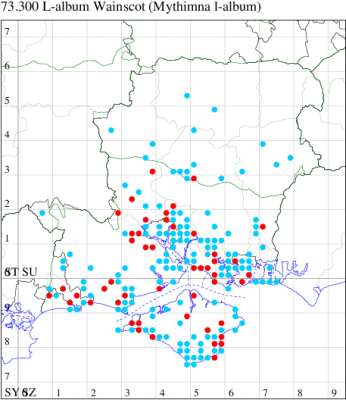
Records by year
Records by week (adult)
Records by week (larval)
Record Summary
VC10: Earliest: Totland, 27 May, 1 (RTer) Latest: Bonchurch, 09 Nov, 2 (JHa) Max count: Freshwater, 06 Oct, 10 (DCoo)
VC11: Earliest: Southsea, 07 Jun, 1 (JRL) Latest: Fareham, 27 Oct, 1 (IMcP) Max count: Marchwood, 25 Sep, 13 (CTha)
VC12: Earliest: Morn Hill, Winchester, 08 Oct, 1 (CBey, DAS, PDF) Max count: Morn Hill, Winchester, 08 Oct, 1 (CBey, DAS, PDF)
73.301 [B&F: 2205] Shoulder-striped Wainscot Leucania comma (Linnaeus, 1761) - Common
Common in fens, marshes, grassland, gardens and damp woodland throughout the British Isles, a species of conservation concern under the UK Biodiversity Action Plan. Widespread and still moderately common in Hampshire and on the Isle of Wight. Wingspan 35-42 mm. The long, thick, black streak from base to centre of wing, white costal streak, and prominent, white, finger-like veins reaching from centre of wing to termen are diagnostic. Larva feeds on various grasses, especially Cock's-foot, over-wintering in a cocoon.
Records prior to 2021
| Vice County | #Records | #Individuals | First Record | Last Record |
|---|---|---|---|---|
| 10 | 314 | 700 | 1951 | 2020 |
| 11 | 2330 | 3981 | 1951 | 2020 |
| 12 | 715 | 1045 | 1948 | 2020 |
2021 records
| Vice County | #Records | #Individuals | Max Quantity |
|---|---|---|---|
| 10 | 23 | 29 | 3 |
| 11 | 85 | 138 | 10 |
| 12 | 22 | 30 | 4 |
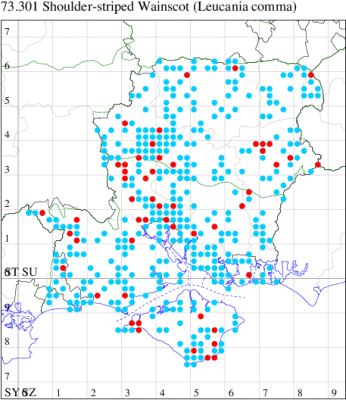
Records by year
Records by week (adult)
Records by week (larval)
Record Summary
VC10: Earliest: Freshwater Bay, 02 Jun, 2 (SDav) Latest: Shanklin, 14 Jul, 1 (IOut) Max count: Totland, 24 Jun, 3 (RTer)
VC11: Earliest: Fordingbridge, 04 Jun, 1 (SCT) Latest: Nursling, 31 Jul, 1 (JWal) Max count: Furzehill, NF, 29 Jun, 10 (SLoa)
VC12: Earliest: Alton, 08 Jun, 1 (DBO) Latest: Alton, 18 Jul, 1 (NDP) Max count: Old Basing, Basingstoke, 20 Jun, 4 (SVic)
73.302 [B&F: 2204] Obscure Wainscot Leucania obsoleta (Hübner, [1803]) - Local
Local in reed-beds, and by fens, ponds and other freshwater margins throughout much of southern and eastern England. In Hampshire and on the Isle of Wight local in reed-beds, with only occasional records away from this habitat, but no doubt present in all large reed-beds in the county. Wingspan 36-40 mm. Similar to Southern Wainscot M. straminea in many respects. Larva feeds on Common Reed.
Records prior to 2021
| Vice County | #Records | #Individuals | First Record | Last Record |
|---|---|---|---|---|
| 10 | 9 | 2 | 1856 | 2017 |
| 11 | 478 | 993 | 1800 | 2020 |
| 12 | 249 | 679 | 1940 | 2020 |
2021 records
| Vice County | #Records | #Individuals | Max Quantity |
|---|---|---|---|
| 11 | 8 | 12 | 5 |
| 12 | 3 | 3 | 1 |
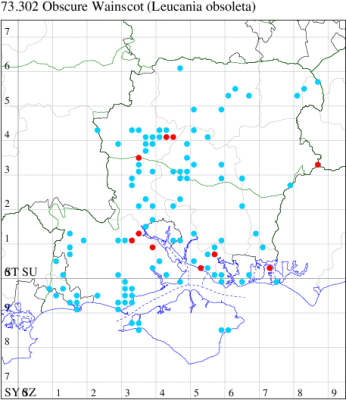
Records by year
Records by week (adult)
Records by week (larval)
Record Details
VC11: Marchwood, one, 14 Jun; two, 16 Jun (CTha); Woodlands, NF, present, 02 Jun (RBW); Totton, one, field observation, 14 Jun (SSto); Stockbridge Down NT, one, 18 Jul (GCE); Titchfield Haven NNR, five, 25 Jun (RJD, DWal, KJW, RCar, DHun det. RJD); Fareham, one, 02 Jun (MLO); Northney, one, 13 Jun (IMea);
VC12: Barton Stacey, one, 10 Jun; Bullington, one, 10 Jun (GCE); Hammer Vale, one, 19 Jul (ASwa)
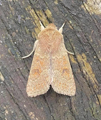
()(IMG_6007).jpg)
(f)(IMG_6038).jpg)
()(IMG_5992).jpg)
()(IMG_5534).jpg)
()(IMG_5948).jpg)
()(IMG_5625).jpg)